Literature Review of Hybrid CO2 Low Salinity Water-Alternating-Gas Injection and Investigation on Hysteresis Effect
Abstract
1. Introduction
2. Bibliometric Study
2.1. Identification and Filtering
2.2. Discussion of Relevant Literature
- CO2 WAG injection
- ❖
- Miscible and immiscible process
- ❖
- Hysteresis effect
- LSWI
- ❖
- Mechanisms in sandstone
- ❖
- Mechanisms in carbonate
- CO2 LSWAG injection
- ❖
- Experimental studies and effect of different parameters
- ○
- Miscibility
- ○
- CO2 solubility
- ○
- Brine salinity and composition
- ○
- Rock composition
- ○
- WAG parameters
- ○
- Wettability
- ○
- Pressure and temperature
- ❖
- Simulation studies
- ○
- Core scale
- ○
- Field scale
3. CO2 WAG Injection
3.1. Miscible Process
3.2. Immiscible Process
3.3. Hysteresis
4. Low Salinity Water Injection (LSWI)
4.1. Proposed Mechanism of LSWI in Sandstone
4.2. Proposed Mechanism of LSWI in Carbonate
5. CO2 LSWAG Injection
5.1. Laboratory Observations of CO2 LSWAG Injection
5.1.1. Effect of Miscibility
5.1.2. Effect of CO2 Solubility in Brine
5.1.3. Effect of Brine Composition and Salinity
5.1.4. Effect of Rock Composition
5.1.5. Effect of WAG Parameters
5.1.6. Effect of Wettability
5.1.7. Effect of Pressure and Temperature
5.2. Simulation Studies of CO2 LSWAG Injection
5.3. Proposed Mechanisms of CO2 LSWAG Injection
5.4. Working Conditions and Screening Criteria for CO2 LSWAG Injection
5.5. Research Gap
5.6. Environmental Aspects of CO2
6. Simulation Investigation on Hysteresis Effect
6.1. Modeling of CO2 LSWAG Injection and Hysteresis Effect
6.1.1. Hysteresis Modeling
6.1.2. Core-Scale Model and LSWI Description
6.1.3. Modeling Investigation Approach
6.2. Results and Discussion
6.2.1. Effect of Hysteresis Model on Oil Recovery
6.2.2. Effect of Salinity
7. Conclusions
- The EOR potential of CO2 LSWAG injection has been confirmed by laboratory experiments and simulation studies. Initial wettability, the composition and salinity of injection and formation brine, WAG parameters, and reservoir pressure and temperature determine the success of this method;
- Laboratory experiments suggest that mobility control and wettability alteration (towards more water-wet) could be the dominant mechanisms for CO2 LSWAG injection;
- Clay content might not be an essential requirement for EOR using CO2 LSWAG injection as EOR potential has been observed with core samples with no clay content and core samples with less than 0.5% or 2–6% clay have reported both oil recovery increase or no oil recovery increase. This could be because the low salinity effect in a CO2 LSWAG injection differs from LSWI alone. In a CO2 LSWAG injection, low salinity effect could be similar to a LSWI, or similar to carbonated water injection as lower salinity leads to higher CO2 solubility in water, resulting in in situ carbonated water effect for increased oil recovery.
- Simulation studies proposed two effects for CO2 LSWAG injection. One is that LSWI could potentially compensate for the delayed production by CO2 WAG injection in the early stage, and the injection of CO2 promotes ion exchange and geochemical reactions for LSWI due to its reaction with water and calcite minerals. The other one is that fines migration, and subsequent water blockage induced by fines plugging, divert the flow path to unswept low permeability zones. Due to the lack of experimental evidence, more laboratory experiments, especially pore-scale studies, are recommended to investigate the driving forces and mechanisms for improved oil recovery by CO2 LSWAG injection;
- There is no consensus as to which mechanisms are dominant in improving oil recovery during LSWI, and limited research on the interactions between CO2, crude oil, brine and reservoir rocks. Hence, extensive laboratory studies and simulations on a field scale should be conducted prior to any field-scale application of CO2 LSWAG injection;
- Development of a more reliable CO2 LSWAG injection model is necessary, considering geochemical interactions of the crude oil/brine/rock, three-phase relative permeability, capillary pressure, and hysteresis effect;
- Further investigations are required to thoroughly understand the effect of interactions between crude oil, low salinity water, rock minerals and CO2 on wettability modification during CO2 LSWAG injection;
- Despite the existing challenges, this hybrid technique has the potential to improve oil recovery at low cost in both offshore and onshore reservoirs with ongoing or planned water flooding and CO2 WAG injection projects; and
- Our simulation investigation on the hysteresis effect indicates that it is more accurate to include hysteresis in CO2 LSWAG injection modeling and optimization. In our study with respect salinity effect on oil recovery considering hysteresis, higher oil recovery is obtained with salinity of 5000 ppm instead of 2000 ppm, indicating that lower salinity in a CO2 LSWAG injection with hysteresis effect considered might not lead to higher oil recovery. Even though the hysteresis effect is not significant at core scale, excluding it at reservoir scale might lead to large errors in oil recovery prediction as well as operational parameters and salinity optimization. Moreover, more laboratory data with respect to the imbibition and drainage curves considering different salinities is also required to better model the CO2 LSWAG injection process.
Author Contributions
Funding
Acknowledgments
Conflicts of Interest
Nomenclature
| Acronyms | |
| API | American Petroleum Institute |
| BHP | Bottom hole pressure |
| Ca2+ | Calcium ion |
| CaCl2 | Calcium chloride |
| Cl− | Chloride ion |
| CMG | Computer Modeling Group |
| CO2 | Carbon dioxide |
| COBR | Crude-oil/brine/rock |
| DECE | Designed exploration-controlled evolution |
| EOR | Enhanced Oil Recovery |
| GA | Genetic algorithm |
| HCO3− | Bicarbonate ion |
| H2CO3 | Carbonic acid |
| HS | High salinity |
| HSW | High salinity water |
| IFT | Interfacial tension |
| LPG | Liquified petroleum gases |
| LS | Low salinity |
| LSE | Low salinity effect |
| LSW | Low salinity water |
| LSWAG | Low salinity water-alternating-gas |
| LSWI | Low salinity water injection |
| K+ | Potassium ion |
| KCl | Potassium chloride |
| Krg | Gas relative permeability |
| Na+ | Sodium ion |
| NaCl | Sodium chloride |
| Na2SO4 | Sodium sulfate |
| md | Milli Darcy |
| Mg2+ | Magnesium ion |
| MgCl2 | Magnesium chloride |
| MIE | Multi-component ionic exchange |
| MMP | Minimum miscible pressure |
| MSW | Modified seawater |
| NPV | Net present value |
| OOIP | Original oil in place |
| ppm | Parts per million |
| PSO | Particle swarm optimization |
| PV | Pore volume |
| RSM | Response surface methodology |
| Sg | Gas saturation |
| Sgcrit | Critical gas saturation |
| Sgf | Free gas saturation |
| Sg,max | Maximum gas saturation at the flow reversal |
| Sgr | Trapped gas saturation |
| SO42− | Sulfate ion |
| Sw | Water saturation |
| TDS | Total dissolved solids |
| UTCOMP | Compositional and multiphase flow simulator |
| WAG | Water-alternating-gas |
| WI | Wettability index |
| 0NaCl | Without NaCl |
| 0NaCl-d5Ca | Without NaCl and 5-time diluted Ca2+ |
| 0NaCl-d5Mg | Without NaCl and 5-time diluted Mg2+ |
| 0NaCl-d5SO4 | Without NaCl and 5-time diluted SO42− |
| Variables and parameters | |
| M | Mobility ratio |
| V | Volume fraction |
| Greek letters | |
| ζ | Zeta potential |
| λ | Mobility |
| θ | Contact angle |
| β | Coefficient |
| ν | Velocity |
References
- Sheng, J.J. Enhanced Oil Recovery Field Case Studies; Gulf Professional Publishing: Woburn, MA, USA, 2013. [Google Scholar]
- Al-Murayri, M.; Al-Mayyan, H.; Moudi, K.; Al-Ajmi, F.; Pitts, D.; Wyatt, M.; French, K.; Surtek, J.; Dean, E. Chemical EOR Economic Evaluation in a Low Oil Price Environment: Sabriyah Lower Burgan Reservoir Case Study. In Proceedings of the SPE EOR Conference at Oil and Gas West Asia, Muscat, Oman, 26–28 March 2018; Society of Petroleum Engineers: Richardson, TX, USA, 2018. [Google Scholar]
- Sheng, J. Critical review of low-salinity waterflooding. J. Pet. Sci. Eng. 2014, 120, 216–224. [Google Scholar] [CrossRef]
- Afzali, S.; Rezaei, N.; Zendehboudi, S. A comprehensive review on enhanced oil recovery by water alternating gas (WAG) injection. Fuel 2018, 227, 218–246. [Google Scholar] [CrossRef]
- Dang, C.T.; Nghiem, L.X.; Chen, Z.; Nguyen, N.T.; Nguyen, Q.P. CO2 low salinity water alternating gas: A new promising approach for enhanced oil recovery. In Proceedings of the SPE Improved Oil Recovery Symposium, Tulsa, OK, USA, 14–18 April 2014; Society of Petroleum Engineers: Richardson, TX, USA, 2014. [Google Scholar]
- Dang, C.; Nghiem, L.; Nguyen, N.; Chen, Z.; Nguyen, Q. Evaluation of CO2 low salinity water-alternating-gas for enhanced oil recovery. J. Nat. Gas Sci. Eng. 2016, 35, 237–258. [Google Scholar] [CrossRef]
- Zolfaghari, H.; Zebarjadi, A.; Shahrokhi, O.; Ghazanfari, M.H. An experimental study of CO2-low salinity water alternating gas injection in sandstone heavy oil reservoirs. Iran. J. Oil Gas Sci. Technol. 2013, 2, 37–47. [Google Scholar]
- Chaturvedi, K.R.; Ravilla, D.; Keleem, W.; Jadhawar, P.; Sharma, T. Impact of Low Salinity Water Injection on CO2 Storage and Oil Recovery for Improved CO2 Utilization. Chem. Eng. Sci. 2020, 229, 11. [Google Scholar] [CrossRef]
- Teklu, T.W.; Alameri, W.; Graves, R.M.; Kazemi, H.; Al-sumaiti, A.M. Low-salinity water-alternating-CO2 flooding enhanced oil recovery: Theory and experiments. In Proceedings of the Abu Dhabi International Petroleum Exhibition and Conference, Abu Dhabi, United Arab Emirates, 31 October–3 November 2014; Society of Petroleum Engineers: Richardson, TX, USA, 2014. [Google Scholar]
- Ramanathan, R.; Shehata, A.; Nasr-El-Din, H. Water Alternating CO2 Injection Process-Does Modifying the Salinity of Injected Brine Improve Oil Recovery? In Proceedings of the OTC Brasil, Rio de Janeiro, Brazil, 27 October 2015; Offshore Technology Conference: Rio de Janeiro, Brazil, 2015. [Google Scholar]
- Jiang, H.; Nuryaningsih, L.; Adidharma, H. The effect of salinity of injection brine on water alternating gas performance in tertiary miscible carbon dioxide flooding: Experimental study. In Proceedings of the SPE Western Regional Meeting, Bakersfield, CA, USA, 5 November 2010; Society of Petroleum Engineers: Richardson, TX, USA, 2010. [Google Scholar]
- Lake, L.W. Enhanced Oil Recovery; Prentice Hall: Englewood Cliffs, NJ, USA, 1989. [Google Scholar]
- Holm, L.; Josendal, V. Mechanisms of oil displacement by carbon dioxide. J. Pet. Technol. 1974, 26, 1427–1438. [Google Scholar] [CrossRef]
- Perera, M.S.A.; Gamage, R.P.; Rathnaweera, T.D.; Ranathunga, A.S.; Koay, A.; Choi, X. A review of CO2-enhanced oil recovery with a simulated sensitivity analysis. Energies 2016, 9, 481. [Google Scholar] [CrossRef]
- Czernichowski-Lauriol, I.; Rochelle, C.; Gaus, I.; Azaroual, M.; Pearce, J.; Durst, P. Geochemical interactions between CO2, pore-waters and reservoir rocks. In Advances in the Geological Storage of Carbon Dioxide; Springer: Berlin/Heidelberg, Germany, 2006; pp. 157–174. [Google Scholar]
- Crawford, H.; Neill, G.; Bucy, B.; Crawford, P.B. Carbon dioxide-a multipurpose additive for effective well stimulation. J. Pet. Technol. 1963, 15, 237–242. [Google Scholar] [CrossRef]
- Ahmed, T. Equations of State and PVT Analysis; Elsevier: Amsterdam, The Netherlands, 2013. [Google Scholar]
- Verma, M.K. Fundamentals of Carbon Dioxide-Enhanced Oil Recovery (CO2-EOR): A Supporting Document of the Assessment Methodology for Hydrocarbon Recovery Using CO2-EOR Associated with Carbon Sequestration; US Department of the Interior, US Geological Survey: Washington, DC, USA, 2015.
- Holtz, M.H.; Nance, P.K.; Finley, R.J. Reduction of greenhouse gas emissions through CO2 EOR in Texas. Environ. Geosci. 2001, 8, 187–199. [Google Scholar] [CrossRef]
- Zhang, H.; Hou, D.; Li, K. An improved CO2-crude oil minimum miscibility pressure correlation. J. Chem. 2015, 2015, 175940. [Google Scholar] [CrossRef]
- Jarrell, P.M.; Fox, C.E.; Stein, M.H.; Webb, S.L. Practical Aspects of CO2 Flooding; Society of Petroleum Engineers: Richardson, TX, USA, 2002; Volume 22. [Google Scholar]
- Welker, J. Physical properties of carbonated oils. J. Pet. Technol. 1963, 15, 873–876. [Google Scholar] [CrossRef]
- Chung, F.T.; Jones, R.A.; Burchfield, T. Recovery of viscous oil under high pressure by CO2 displacement: A laboratory study. In Proceedings of the International Meeting on Petroleum Engineering, Tianjin, China, 1–4 November 1988; Society of Petroleum Engineers: Richardson, TX, USA, 1988. [Google Scholar]
- Chung, F.T.; Jones, R.A.; Nguyen, H.T. Measurements and correlations of the physical properties of CO2-heavy crude oil mixtures. SPE Reserv. Eng. 1988, 3, 822–828. [Google Scholar] [CrossRef]
- DeRuiter, R.; Nash, L.; Singletary, M. Solubility and displacement behavior of a viscous crude with CO2 and hydrocarbon gases. SPE Reserv. Eng. 1994, 9, 101–106. [Google Scholar] [CrossRef]
- Kokal, S.L.; Sayegh, S.G. Phase behavior and physical properties of CO2-saturated heavy oil and its constitutive fractions: Experimental data and correlations. J. Pet. Sci. Eng. 1993, 9, 289–302. [Google Scholar] [CrossRef]
- Hatzignatiou, D.; Lu, Y. Feasibility Study of CO2 Immiscible Displacement Process In Heavy Oil Reservoirs. In Proceedings of the Annual Technical Meeting, New Orleans, LA, USA, 25–28 September 1994; Petroleum Society of Canada: Richardson, TX, USA, 1994. [Google Scholar]
- Yang, C.; Gu, Y. Diffusion coefficients and oil swelling factors of carbon dioxide, methane, ethane, propane, and their mixtures in heavy oil. Fluid Phase Equilibria 2006, 243, 64–73. [Google Scholar] [CrossRef]
- Klins, M.A.; Ali, S. Heavy oil production by carbon dioxide injection. J. Can. Pet. Technol. 1982, 21, 82-05-06. [Google Scholar] [CrossRef]
- Svrcek, W.Y.; Mehrotra, A.K. Gas solubility, viscosity and density measurements for Athabasca bitumen. J. Can. Pet. Technol. 1982, 21, 82-04-02. [Google Scholar] [CrossRef]
- Gao, C.; Li, X.; Guo, L.; Zhao, F. Heavy oil production by carbon dioxide injection. Greenh. Gases: Sci. Technol. 2013, 3, 185–195. [Google Scholar] [CrossRef]
- Touray, S. Effect of water alternating gas injection on ultimate oil recovery. Master Eng. Dalhous. Univ. 2013, 25, 11–15. [Google Scholar]
- Wang, G.C. A laboratory study of the effects of CO2 injection sequence on tertiary oil recovery. Soc. Pet. Eng. J. 1980, 20, 278–280. [Google Scholar] [CrossRef]
- Bennion, D.B.; Thomas, F.B.; Jamaluddin, A.; Ma, T. The effect of trapped critical fluid saturations on reservoir permeability and conformance. In Proceedings of the Annual Technical Meeting of the Petroleum Society of CIM, Calgary, AB, Canada, 28–31 May 1998; pp. 8–10. [Google Scholar]
- Zuo, L.; Chen, Y.; Dengen, Z.; Kamath, J. Three-phase relative permeability modeling in the simulation of WAG injection. SPE Reserv. Eval. Eng. 2014, 17, 326–339. [Google Scholar] [CrossRef]
- Duchenne, S.; de Loubens, R.; Petitfrere, M.; Joubert, T. Modeling and simultaneous history-matching of multiple WAG coreflood experiments at reservoir conditions. In Proceedings of the Abu Dhabi International Petroleum Exhibition and Conference, Abu Dhabi, United Arab Emirates, 9–12 November 2015; Society of Petroleum Engineers: Richardson, TX, USA, 2015. [Google Scholar]
- Bernard, G.G. Effect of floodwater salinity on recovery of oil from cores containing clays. In Proceedings of the SPE California Regional Meeting, Los Angeles, CA, USA, 26 October 1967; Society of Petroleum Engineers: Richardson, TX, USA, 1967. [Google Scholar]
- Jadhunandan, P.; Morrow, N.R. Effect of wettability on waterflood recovery for crude-oil/brine/rock systems. SPE Reserv. Eng. 1995, 10, 40–46. [Google Scholar] [CrossRef]
- Jadhunandan, P.P. Effects of Brine Composition, Crude Oil, and Aging Conditions on Wettability and Oil Recovery. Ph.D. Thesis, Department of Petroleum Engineering, New Mexico Institute of Mining & Technology, Socorro, NM, USA, 1990. [Google Scholar]
- Morrow, N.; Valat, M.; Yidliz, H. Effect of brine composition on recovery of an Alaskan crude oil by waterflooding. In Proceedings of the Annual Technical Meeting, San Diego, CA, USA, 22–26 January 1996; Society of Petroleum Engineers: Richardson, TX, USA, 1996. [Google Scholar]
- Tang, G.Q.; Morrow, N.R. Influence of brine composition and fines migration on crude oil/brine/rock interactions and oil recovery. J. Pet. Sci. Eng. 1999, 24, 99–111. [Google Scholar] [CrossRef]
- Tang, G.; Morrow, N.R. Salinity, temperature, oil composition, and oil recovery by waterflooding. SPE Reserv. Eng. 1997, 12, 269–276. [Google Scholar] [CrossRef]
- Webb, K.; Black, C.; Al-Ajeel, H. Low salinity oil recovery-log-inject-log. In Proceedings of the Middle East Oil Show, Sakhir, Bahrain, 9 June 2003; Society of Petroleum Engineers: Richardson, TX, USA, 2003. [Google Scholar]
- Webb, K.J.; Black, C.J.J.; Tjetland, G. A laboratory study investigating methods for improving oil recovery in carbonates. In Proceedings of the International Petroleum Technology Conference, Doha, Qatar, 21 November 2005. [Google Scholar]
- Gupta, R.; Smith, G.G.; Hu, L.; Willingham, T.; Lo Cascio, M.; Shyeh, J.J.; Harris, C.R. Enhanced waterflood for carbonate reservoirs-impact of injection water composition. In Proceedings of the SPE Middle East Oil and Gas Show and Conference, Manama, Bahrain, 25–28 September 2011; Society of Petroleum Engineers: Richardson, TX, USA, 2011. [Google Scholar]
- Soraya, B.; Malick, C.; Philippe, C.; Bertin, H.J.; Hamon, G. Oil recovery by low-salinity brine injection: Laboratory results on outcrop and reservoir cores. In Proceedings of the SPE Annual Technical Conference and Exhibition, New Orleans, LA, USA, 4–7 October 2009; Society of Petroleum Engineers: Richardson, TX, USA, 2009. [Google Scholar]
- Ligthelm, D.J.; Gronsveld, J.; Hofman, J.; Brussee, N.; Marcelis, F.; van der Linde, H. Novel Waterflooding Strategy By Manipulation Of Injection Brine Composition. In Proceedings of the EUROPEC/EAGE Conference and Exhibition, Amsterdam, The Netherlands, 8–11 June 2009; Society of Petroleum Engineers: Richardson, TX, USA, 2009. [Google Scholar]
- Mahani, H.; Sorop, T.; Ligthelm, D.J.; Brooks, D.; Vledder, P.; Mozahem, F.; Ali, Y. Analysis of field responses to low-salinity waterflooding in secondary and tertiary mode in Syria. In Proceedings of the SPE Europec/EAGE Annual Conference and Exhibition, Aberdeen, UK, 6–8 September 2011; Society of Petroleum Engineers: Richardson, TX, USA, 2011. [Google Scholar]
- Romanuka, J.; Hofman, J.; Ligthelm, D.J.; Suijkerbuijk, B.; Marcelis, F.; Oedai, S.; Brussee, N.; van der Linde, H.; Aksulu, H.; Austad, T. Low salinity EOR in carbonates. In Proceedings of the SPE Improved Oil Recovery Symposium, Tulsa, OK, USA, 14–18 April 2012; Society of Petroleum Engineers: Richardson, TX, USA, 2012. [Google Scholar]
- Vledder, P.; Gonzalez, I.E.; Carrera Fonseca, J.C.; Wells, T.; Ligthelm, D.J. Low salinity water flooding: Proof of wettability alteration on a field wide scale. In Proceedings of the SPE Improved Oil Recovery Symposium, Tulsa, OK, USA, 24–28 April 2010; Society of Petroleum Engineers: Richardson, TX, USA, 2010. [Google Scholar]
- Nasralla, R.A.; Bataweel, M.A.; Nasr-El-Din, H.A. Investigation of wettability alteration and oil-recovery improvement by low-salinity water in sandstone rock. J. Can. Pet. Technol. 2013, 52, 144–154. [Google Scholar] [CrossRef]
- Skrettingland, K.; Holt, T.; Tweheyo, M.T.; Skjevrak, I. Snorre Low-Salinity-Water Injection—Coreflooding Experiments and Single-Well Field Pilot. SPE Reserv. Eval. Eng. 2011, 14, 182–192. [Google Scholar] [CrossRef]
- RezaeiDoust, A.; Puntervold, T.; Strand, S.; Austad, T. Smart water as wettability modifier in carbonate and sandstone: A discussion of similarities/differences in the chemical mechanisms. Energy Fuels 2009, 23, 4479–4485. [Google Scholar] [CrossRef]
- Yousef, A.A.; Al-Saleh, S.H.; Al-Kaabi, A.; Al-Jawfi, M.S. Laboratory investigation of the impact of injection-water salinity and ionic content on oil recovery from carbonate reservoirs. SPE Reserv. Eval. Eng. 2011, 14, 578–593. [Google Scholar] [CrossRef]
- Morrow, N.; Buckley, J. Improved oil recovery by low-salinity waterflooding. J. Pet. Technol. 2011, 63, 106–112. [Google Scholar] [CrossRef]
- Boston, W.G.; Brandner, C.F.; Foster, W.R. Recovery of Oil by Waterflooding from an Argillaceous, Oil-Containing Subterranean Formation. U.S. Patent 3,470,956, 7 October 1969. [Google Scholar]
- Song, W.; Kovscek, A.R. Direct visualization of pore-scale fines migration and formation damage during low-salinity waterflooding. J. Nat. Gas Sci. Eng. 2016, 34, 1276–1283. [Google Scholar] [CrossRef]
- Austad, T.; RezaeiDoust, A.; Puntervold, T. Chemical mechanism of low salinity water flooding in sandstone reservoirs. In Proceedings of the SPE Improved Oil Recovery Symposium, Tulsa, OK, USA, 24–28 April 2010; Society of Petroleum Engineers: Richardson, TX, USA, 2010. [Google Scholar]
- Velde, B. Origin and Mineralogy of Clays: Clays and the Environment; Springer Science & Business Media: New York, NY, USA, 2013. [Google Scholar]
- McGuire, P.; Chatham, J.; Paskvan, F.; Sommer, D.; Carini, F. Low salinity oil recovery: An exciting new EOR opportunity for Alaska’s North Slope. In Proceedings of the SPE Western Regional Meeting, Irvine, CA, USA, 30 March–1 April 2005; Society of Petroleum Engineers: Richardson, TX, USA, 2005. [Google Scholar]
- Fredriksen, S.; Rognmo, A.; Sandengen, K.; Fernø, M. Wettability effects on osmosis as an oil-mobilization mechanism during low-salinity waterflooding. Petrophysics 2017, 58, 28–35. [Google Scholar]
- Fakcharoenphol, P.; Kurtoglu, B.; Kazemi, H.; Charoenwongsa, S.; Wu, Y.S. The effect of osmotic pressure on improve oil recovery from fractured shale formations. In Proceedings of the SPE Unconventional Resources Conference, Vienna, Austria, 25–27 February 2014; Society of Petroleum Engineers: Richardson, TX, USA, 2014. [Google Scholar]
- Kurtoglu, B. A rock and fluid study of middle Bakken formation: Key to enhanced oil recovery. In Proceedings of the 76th EAGE Conference and Exhibition 2014, Amsterdam, The Netherlands, 16–19 June 2014; European Association of Geoscientists & Engineers: The Hague, The Netherlands, 2014; pp. 1–5. [Google Scholar]
- Sandengen, K.; Arntzen, O. Osmosis during low salinity water flooding. In Proceedings of the IOR 2013-17th European Symposium on Improved Oil Recovery, St. Petersburg, Russia, 16–18 April 2013; European Association of Geoscientists & Engineers: The Hague, The Netherlands, 2013; p. cp-342-00015. [Google Scholar]
- Sandengen, K.; Kristoffersen, A.; Melhuus, K.; Jøsang, L.O. Osmosis as mechanism for low-salinity enhanced oil recovery. SPE J. 2016, 21, 1227–1235. [Google Scholar] [CrossRef]
- Morrow, N.R.; Tang, G.Q.; Valat, M.; Xie, X. Prospects of improved oil recovery related to wettability and brine composition. J. Pet. Sci. Eng. 1998, 20, 267–276. [Google Scholar] [CrossRef]
- Morrow, N.R. Wettability and its effect on oil recovery. J. Pet. Technol. 1990, 42, 1476–1484. [Google Scholar] [CrossRef]
- Berg, S.; Cense, A.; Jansen, E.; Bakker, K. Direct experimental evidence of wettability modification by low salinity. Petrophysics 2010, 51, SPWLA-2010-v51n5a3. [Google Scholar]
- Nasralla, R.A.; Bataweel, M.A.; Nasr-El-Din, H.A. Investigation of wettability alteration by low salinity water. In Proceedings of the Offshore Europe, Aberdeen, UK, 19–21 July 2011; Society of Petroleum Engineers: Richardson, TX, USA, 2011. [Google Scholar]
- Lager, A.; Webb, K.J.; Black, C.; Singleton, M.; Sorbie, K.S. Low salinity oil recovery-an experimental investigation1. Petrophysics 2008, 49, SPWLA-2008-v49n1a2. [Google Scholar]
- Al-Saedi, H.N.; Brady, P.V.; Flori, R.E.; Heidari, P. Insights into the role of clays in low salinity water flooding in sand columns. J. Pet. Sci. Eng. 2019, 174, 291–305. [Google Scholar] [CrossRef]
- Mitchell, J.K.; Soga, K. Fundamentals of Soil Behavior; John Wiley & Sons: New York, NY, USA, 2005; Volume 3. [Google Scholar]
- van Olphen, H. An introduction to clay colloid chemistry. Soil Sci. 1964, 97, 290. [Google Scholar] [CrossRef]
- Pu, H.; Xie, X.; Yin, P.; Morrow, N.R. Low salinity waterflooding and mineral dissolution. In Proceedings of the SPE Annual Technical Conference and Exhibition, New Orleans, LA, USA, 2 February 2010; OnePetro: Richardson, TX, USA, 2010. [Google Scholar]
- Katende, A.; Sagala, F. A critical review of low salinity water flooding: Mechanism, laboratory and field application. J. Mol. Liq. 2019, 278, 627–649. [Google Scholar] [CrossRef]
- Al-Shalabi, E.W.; Sepehrnoori, K. A comprehensive review of low salinity/engineered water injections and their applications in sandstone and carbonate rocks. J. Pet. Sci. Eng. 2016, 139, 137–161. [Google Scholar] [CrossRef]
- Yue, L.; Pu, W.; Zhao, S.; Zhang, S.; Ren, F.; Xu, D. Insights into mechanism of low salinity water flooding in sandstone reservoir from interfacial features of oil/brine/rock via intermolecular forces. J. Mol. Liq. 2020, 313, 113435. [Google Scholar] [CrossRef]
- Mahmoud, M.; Nasr-El-Din, H. Challenges during shallow and deep carbonate reservoirs stimulation. J. Energy Resour. Technol. 2015, 137, 012902. [Google Scholar] [CrossRef]
- Yue, W.; Yilin Wang, J. Feasibility of waterflooding for a carbonate oil field through whole-field simulation studies. J. Energy Resour. Technol. 2015, 137, 064501. [Google Scholar] [CrossRef]
- Standnes, D.C.; Austad, T. Wettability alteration in chalk: 2. Mechanism for wettability alteration from oil-wet to water-wet using surfactants. J. Pet. Sci. Eng. 2000, 28, 123–143. [Google Scholar] [CrossRef]
- Austad, T. Water-based EOR in carbonates and sandstones: New chemical understanding of the EOR potential using “Smart Water”. In Enhanced Oil Recovery Field Case Studies; Elsevier: Amsterdam, The Netherlands, 2013; pp. 301–335. [Google Scholar]
- Yousef, A.A.; Al-Saleh, S.; Al-Jawfi, M.S. The impact of the injection water chemistry on oil recovery from carbonate reservoirs. In Proceedings of the SPE EOR Conference at Oil and Gas West Asia, Muscat, Oman, 16–18 April 2012; Society of Petroleum Engineers: Richardson, TX, USA, 2012. [Google Scholar]
- Strand, S.; Høgnesen, E.J.; Austad, T. Wettability alteration of carbonates—Effects of potential determining ions (Ca2+ and SO42−) and temperature. Colloids Surf. A Physicochem. Eng. Asp. 2006, 275, 1–10. [Google Scholar] [CrossRef]
- Strand, S.; Puntervold, T.; Austad, T. Effect of temperature on enhanced oil recovery from mixed-wet chalk cores by spontaneous imbibition and forced displacement using seawater. Energy Fuels 2008, 22, 3222–3225. [Google Scholar] [CrossRef]
- Zhang, P.; Tweheyo, M.T.; Austad, T. Wettability alteration and improved oil recovery in chalk: The effect of calcium in the presence of sulfate. Energy Fuels 2006, 20, 2056–2062. [Google Scholar] [CrossRef]
- Zhang, P.; Tweheyo, M.T.; Austad, T. Wettability alteration and improved oil recovery by spontaneous imbibition of seawater into chalk: Impact of the potential determining ions Ca2+, Mg2+, and SO42−. Colloids Surf. A: Physicochem. Eng. Asp. 2007, 301, 199–208. [Google Scholar] [CrossRef]
- Strand, S.; Austad, T.; Puntervold, T.; Høgnesen, E.J.; Olsen, M.; Barstad, S.M.F. “Smart water” for oil recovery from fractured limestone: A preliminary study. Energy Fuels 2008, 22, 3126–3133. [Google Scholar] [CrossRef]
- Yousef, A.A.; Al-Saleh, S.; Al-Kaabi, A.U.; Al-Jawfi, M.S. Laboratory investigation of novel oil recovery method for carbonate reservoirs. In Proceedings of the Canadian Unconventional Resources and International Petroleum Conference, Calgary, AB, Canada, 19–21 October 2010; Society of Petroleum Engineers: Richardson, TX, USA, 2010. [Google Scholar]
- Yousef, A.A.; Al-Salehsalah, S.H.; Al-Jawfi, M.S. New recovery method for carbonate reservoirs through tuning the injection water salinity: Smart waterflooding. In Proceedings of the SPE EUROPEC/EAGE Annual Conference and Exhibition, Aberdeen, UK, 6–8 September 2011; Society of Petroleum Engineers: Richardson, TX, USA, 2011. [Google Scholar]
- Hiorth, A.; Cathles, L.; Madland, M. The impact of pore water chemistry on carbonate surface charge and oil wettability. Transp. Porous Media 2010, 85, 1–21. [Google Scholar] [CrossRef]
- Aleidan, A.A.; Mamora, D.D. SWACO2 and WACO2 efficiency improvement in carbonate cores by lowering water salinity. In Proceedings of the Canadian Unconventional Resources and International Petroleum Conference, Calgary, AB, Canada, 19–21 October 2010; Society of Petroleum Engineers: Richardson, TX, USA, 2010. [Google Scholar]
- Teklu, T.W.; Alameri, W.; Kazemi, H.; Graves, R.M.; AlSumaiti, A.M. Low salinity water–Surfactant–CO2 EOR. Petroleum 2017, 3, 309–320. [Google Scholar] [CrossRef]
- Zekri, A.; Al-Attar, H.; Al-Farisi, O.; Almehaideb, R.; Lwisa, E.G. Experimental investigation of the effect of injection water salinity on the displacement efficiency of miscible carbon dioxide WAG flooding in a selected carbonate reservoir. J. Pet. Explor. Prod. Technol. 2015, 5, 363–373. [Google Scholar] [CrossRef]
- Le Van, S.; Chon, B.H. Effects of salinity and slug size in miscible CO2 water-alternating-gas core flooding experiments. J. Ind. Eng. Chem. 2017, 52, 99–107. [Google Scholar] [CrossRef]
- Al-Saedi, H.N.; Flori, R.E. Novel Coupling Smart Water-CO2 Flooding for Sandstone Reservoirs. Petrophysics 2019, 60, 525–535. [Google Scholar]
- AlQuraishi, A.A.; Amao, A.M.; Al-Zahrani, N.I.; AlQarni, M.T.; AlShamrani, S.A. Low salinity water and CO2 miscible flooding in Berea and Bentheimer sandstones. J. King Saud Univ. Eng. Sci. 2019, 31, 286–295. [Google Scholar] [CrossRef]
- Al-Abri, H.; Pourafshary, P.; Mosavat, N.; Al Hadhrami, H. A study of the performance of the LSWA CO2 EOR technique on improvement of oil recovery in sandstones. Petroleum 2019, 5, 58–66. [Google Scholar] [CrossRef]
- Al-Saedi, H.N.; Long, Y.; Flori, R.E.; Bai, B. Coupling smart seawater flooding and CO2 flooding for sandstone reservoirs: Smart seawater alternating CO2 flooding (SMSW-AGF). Energy Fuels 2019, 33, 9644–9653. [Google Scholar] [CrossRef]
- Moradpour, N.; Pourafshary, P.; Zivar, D. Experimental analysis of hybrid low salinity water alternating gas injection and the underlying mechanisms in carbonates. J. Pet. Sci. Eng. 2021, 202, 108562. [Google Scholar] [CrossRef]
- Christensen, J.R.; Stenby, E.H.; Skauge, A. Review of WAG field experience. In Proceedings of the International Petroleum Conference and Exhibition of Mexico, Villahermosa, Mexico, 3–5 March 1998; Society of Petroleum Engineers: Richardson, TX, USA, 1998. [Google Scholar]
- Thomas, F.; Erian, A.; Chan, M.; Bennion, D.; Bennion, D.; Okazawa, T. Does miscibility matter in gas injection? In Proceedings of the Annual Technical Meeting, Regina, SK, Canada, 16–18 October 1995; Petroleum Society of Canada: Richardson, TX, USA, 1995. [Google Scholar]
- Kulkarni, M.M.; Rao, D.N. Experimental investigation of miscible and immiscible Water-Alternating-Gas (WAG) process performance. J. Pet. Sci. Eng. 2005, 48, 1–20. [Google Scholar] [CrossRef]
- Bartels, W.B.; Mahani, H.; Berg, S.; Menezes, R.; van der Hoeven, J.A.; Fadili, A. Oil configuration under high-salinity and low-salinity conditions at pore scale: A parametric investigation by use of a single-channel micromodel. Spe J. 2017, 22, 1362–1373. [Google Scholar] [CrossRef]
- Li, Y.K.; Nghiem, L.X. Phase equilibria of oil, gas and water/brine mixtures from a cubic equation of state and Henry’s law. Can. J. Chem. Eng. 1986, 64, 486–496. [Google Scholar] [CrossRef]
- Enick, R.M.; Klara, S.M. CO2 solubility in water and brine under reservoir conditions. Chem. Eng. Commun. 1990, 90, 23–33. [Google Scholar] [CrossRef]
- Duan, Z.; Sun, R. An improved model calculating CO2 solubility in pure water and aqueous NaCl solutions from 273 to 533 K and from 0 to 2000 bar. Chem. Geol. 2003, 193, 257–271. [Google Scholar] [CrossRef]
- Bennion, D.B.; Bachu, S. Correlations for the interfacial tension between supercritical phase CO2 and equilibrium brines at in situ conditions. In Proceedings of the SPE Annual Technical Conference and Exhibition, Denver, CO, USA, 21–24 September 2008; Society of Petroleum Engineers: Richardson, TX, USA, 2008. [Google Scholar]
- Yang, D.; Tontiwachwuthikul, P.; Gu, Y. Interfacial tensions of the crude oil+ reservoir brine+ CO2 systems at pressures up to 31 MPa and temperatures of 27 °C and 58 °C. J. Chem. Eng. Data 2005, 50, 1242–1249. [Google Scholar] [CrossRef]
- Georgiadis, A.; Maitland, G.; Trusler, J.M.; Bismarck, A. Interfacial tension measurements of the (H2O + CO2) system at elevated pressures and temperatures. J. Chem. Eng. Data 2010, 55, 4168–4175. [Google Scholar] [CrossRef]
- Al-Shalabi, E.W.; Sepehrnoori, K.; Pope, G. Numerical modeling of combined low salinity water and carbon dioxide in carbonate cores. J. Pet. Sci. Eng. 2016, 137, 157–171. [Google Scholar] [CrossRef]
- Naderi, S.; Simjoo, M. Numerical study of low salinity water alternating CO2 injection for enhancing oil recovery in a sandstone reservoir: Coupled geochemical and fluid flow modeling. J. Pet. Sci. Eng. 2019, 173, 279–286. [Google Scholar] [CrossRef]
- Amirian, T.; Haghighi, M.; Mostaghimi, P. Pore scale visualization of low salinity water flooding as an enhanced oil recovery method. Energy Fuels 2017, 31, 13133–13143. [Google Scholar] [CrossRef]
- Yang, C.; Card, C.; Nghiem, L.X.; Fedutenko, E. Robust optimization of SAGD operations under geological uncertainties. In Proceedings of the SPE Reservoir Simulation Symposium, The Woodlands, TX, USA, 24 February 2011; Society of Petroleum Engineers: Richardson, TX, USA, 2011. [Google Scholar]
- Yang, C.; Card, C.; Nghiem, L. Economic optimization and uncertainty assessment of commercial SAGD operations. J. Can. Pet. Technol. 2009, 48, 33–40. [Google Scholar] [CrossRef]
- Yang, C.; Nghiem, L.X.; Card, C.; Bremeier, M. Reservoir model uncertainty quantification through computer-assisted history matching. In Proceedings of the SPE Annual Technical Conference and Exhibition, Anaheim, CA, USA, 14 November 2007; Society of Petroleum Engineers: Richardson, TX, USA, 2007. [Google Scholar]
- Chen, S.; Li, H.; Yang, D.; Tontiwachwuthikul, P. Optimal parametric design for water-alternating-gas (WAG) process in a CO2-miscible flooding reservoir. J. Can. Pet. Technol. 2010, 49, 75–82. [Google Scholar] [CrossRef]
- Mohagheghian, E.; James, L.A.; Haynes, R.D. Optimization of hydrocarbon water alternating gas in the Norne field: Application of evolutionary algorithms. Fuel 2018, 223, 86–98. [Google Scholar] [CrossRef]
- Amar, M.N.; Zeraibi, N.; Redouane, K. Optimization of WAG process using dynamic proxy, genetic algorithm and ant colony optimization. Arab. J. Sci. Eng. 2018, 43, 6399–6412. [Google Scholar] [CrossRef]
- Kulkarni, M.; Rao, D. Experimental investigation of various methods of tertiary gas injection. In Proceedings of the SPE Annual Technical Conference and Exhibition, Denver, CO, USA, 6–9 October 2004; Society of Petroleum Engineers: Richardson, TX, USA, 2004. [Google Scholar]
- Salehi, M.M.; Safarzadeh, M.A.; Sahraei, E.; Nejad, S.A.T. Comparison of oil removal in surfactant alternating gas with water alternating gas, water flooding and gas flooding in secondary oil recovery process. J. Pet. Sci. Eng. 2014, 120, 86–93. [Google Scholar] [CrossRef] [PubMed]
- Salehi, M.M.; Safarzadeh, M.A.; Sahraei, E.; Nejad, S.A.T. Experimental study of surfactant alternating gas injection versus water alternating gas and water flooding enhanced oil recovery methods. J. Pet. Gas Eng. 2013, 4, 160–172. [Google Scholar]
- Anderson, W.G. Wettability literature survey-part 1: Rock/oil/brine interactions and the effects of core handling on wettability. J. Pet. Technol. 1986, 38, 1125–1144. [Google Scholar] [CrossRef]
- Almeida da Costa, A.; Jaeger, P.; Santos, J.; Soares, J.; Embiruçu, M.; Meyberg, G. The Influence of Rock Composition and pH on Reservoir Wettability for Low Salinity Water-CO2 EOR Applications in Brazilian Reservoirs. In Proceedings of the SPE Annual Technical Conference and Exhibition, Brisbane, Australia, 16–18 October 2019; Society of Petroleum Engineers: Richardson, TX, USA, 2019. [Google Scholar]
- Ameri, A.; Kaveh, N.S.; Rudolph, E.; Wolf, K.H.; Farajzadeh, R.; Bruining, J. Investigation on interfacial interactions among crude oil–brine–sandstone rock–CO2 by contact angle measurements. Energy Fuels 2013, 27, 1015–1025. [Google Scholar] [CrossRef]
- Seyyedi, M.; Sohrabi, M.; Farzaneh, A. Investigation of rock wettability alteration by carbonated water through contact angle measurements. Energy Fuels 2015, 29, 5544–5553. [Google Scholar] [CrossRef]
- Shahverdi, H.; Sohrabi, M. Relative permeability characterization for water-alternating-gas injection in oil reservoirs. SPE J. 2016, 21, 0799–0808. [Google Scholar] [CrossRef]
- Agada, S.; Geiger, S.; Elsheikh, A.; Oladyshkin, S. Data-driven surrogates for rapid simulation and optimization of WAG injection in fractured carbonate reservoirs. Pet. Geosci. 2017, 23, 270–283. [Google Scholar] [CrossRef]
- Larsen, J.A.; Skauge, A. Simulation of the immiscible WAG process using cycle-dependent three-phase relative permeabilities. In Proceedings of the SPE annual Technical Conference and Exhibition, Houston, TX, USA, 3–6 October 1999; Society of Petroleum Engineers: Richardson, TX, USA, 1999. [Google Scholar]
- Agada, S.; Geiger, S. Wettability, trapping and fracture-matrix interaction during WAG injection in fractured carbonate reservoirs. In Proceedings of the SPE Improved Oil Recovery Symposium, Tulsa, OK, USA, 23–26 March 2014; Society of Petroleum Engineers: Richardson, TX, USA, 2014. [Google Scholar]
- Kløv, T.; Øren, P.; Stensen, J.; Lerdahl, T.; Berge, L.; Bakke, S.; Boassen, T.; Virnovsky, G. Pore-to-field scale modeling of WAG. In Proceedings of the SPE Annual Technical Conference and Exhibition, Denver, CO, USA, 5–8 October 2003; Society of Petroleum Engineers: Richardson, TX, USA, 2003. [Google Scholar]
- Larsen, J.; Skauge, A. Methodology for numerical simulation with cycle-dependent relative permeabilities. SPE J. 1998, 3, 163–173. [Google Scholar] [CrossRef]
- Sherafati, M.; Jessen, K. Modeling and simulation of WAG injection processes-the role of counter-current flow. In Proceedings of the SPE Western Regional Meeting, Houston, TX, USA, 23–25 February 2015; Society of Petroleum Engineers: Richardson, TX, USA, 2015. [Google Scholar]
- Hustad, O.S.; Browning, D.J. A fully coupled three-phase model for capillary pressure and relative permeability for implicit compositional reservoir simulation. In Proceedings of the SPE/EAGE Reservoir Characterization & Simulation Conference, Abu Dhabi, United Arab Emirates, 14–16 September 2009; European Association of Geoscientists & Engineers: The Hague, The Netherlands, 2009; p. cp-170-00035. [Google Scholar]
- Jerauld, G. General three-phase relative permeability model for Prudhoe Bay. SPE Reserv. Eng. 1997, 12, 255–263. [Google Scholar] [CrossRef]
- Egermann, P.; Vizika, O.; Dallet, L.; Requin, C.; Sonier, F. Hysteresis in three-phase flow: Experiments, modeling and reservoir simulations. In Proceedings of the SPE European Petroleum Conference, Paris, France, 4–25 October 2000; Society of Petroleum Engineers: Richardson, TX, USA, 2000. [Google Scholar]
- Haajizadeh, M.; Narayanan, R.; Waldren, D. Modeling miscible WAG injection EOR in the Magnus field. In Proceedings of the SPE Reservoir Simulation Symposium, Keystone, CO, USA, 21–23 May 2001; Society of Petroleum Engineers: Richardson, TX, USA, 2001. [Google Scholar]
- Rahmawati, S.D.; Whitson, C.H.; Foss, B. A mixed-integer non-linear problem formulation for miscible WAG injection. J. Pet. Sci. Eng. 2013, 109, 164–176. [Google Scholar] [CrossRef]
- Ruan, F.; Carhart, S.; Giordano, R.; Grinestaff, G.; Bratvedt, F.; Olufsen, R. An overview of streamline tracer modeling of miscible/immiscible WAG injection IOR. In Proceedings of the SPE/DOE Improved Oil Recovery Symposium, Tulsa, OK, USA, 13–17 April 2002; Society of Petroleum Engineers: Richardson, TX, USA, 2002. [Google Scholar]
- Fjelde, I.; Asen, S.M.; Omekeh, A.V. Low salinity water flooding experiments and interpretation by simulations. In Proceedings of the SPE Improved Oil Recovery Symposium, Tulsa, OK, USA, 14–18 April 2012; Society of Petroleum Engineers: Richardson, TX, USA, 2012. [Google Scholar]
- Omekeh, A.V.; Friis, H.A.; Fjelde, I.; Evje, S. Modeling of ion-exchange and solubility in low salinity water flooding. In Proceedings of the SPE Improved Oil Recovery Symposium, Tulsa, OK, USA, 14–18 April 2012; Society of Petroleum Engineers: Richardson, TX, USA, 2012. [Google Scholar]
- Dang, C.; Nghiem, L.; Nguyen, N.; Chen, Z.; Nguyen, Q. Mechanistic modeling of low salinity water flooding. J. Pet. Sci. Eng. 2016, 146, 191–209. [Google Scholar] [CrossRef]
- Dang, C.T.Q.; Nghiem, L.X.; Chen, Z.J.; Nguyen, Q.P. Modeling low salinity waterflooding: Ion exchange, geochemistry and wettability alteration. In Proceedings of the SPE Annual Technical Conference and Exhibition, New Orleans, LA, USA, 30 September–2 October 2013; Society of Petroleum Engineers: Richardson, TX, USA, 2013. [Google Scholar]
- Esene, C.; Onalo, D.; Zendehboudi, S.; James, L.; Aborig, A.; Butt, S. Modeling investigation of low salinity water injection in sandstones and carbonates: Effect of Na+ and SO42−. Fuel 2018, 232, 362–373. [Google Scholar] [CrossRef]
- Dang, C.; Nghiem, L.; Nguyen, N.; Chen, Z.; Nguyen, Q. Modeling and optimization of low salinity waterflood. In Proceedings of the SPE Reservoir Simulation Symposium, Houston, TX, USA, 23–25 February 2015; Society of Petroleum Engineers: Richardson, TX, USA, 2015. [Google Scholar]
- Nguyen, N.; Dang, C.; Gorucu, S.E.; Nghiem, L.; Chen, Z. The role of fines transport in low salinity waterflooding and hybrid recovery processes. Fuel 2020, 263, 116542. [Google Scholar] [CrossRef]
- Nghiem, L.; Sammon, P.; Grabenstetter, J.; Ohkuma, H. Modeling CO2 storage in aquifers with a fully-coupled geochemical EOS compositional simulator. In Proceedings of the SPE/DOE Symposium on Improved Oil Recovery, Tulsa, OK, USA, 17–21 April 2004; Society of Petroleum Engineers: Richardson, TX, USA, 2004. [Google Scholar]
- Gorucu, S.E.; Dang, C.; Nghiem, L.; Shrivastava, V. Modeling and Optimization of Low Salinity Waterflood with Fines Transport. In Proceedings of the SPE Annual Technical Conference and Exhibition, Baku, Azerbaijan, 16–18 October 2019; Society of Petroleum Engineers: Richardson, TX, USA, 2019. [Google Scholar]
- Valdya, R.; Fogler, H. Fines migration and formation damage: Influence of pH and ion exchange. SPE Prod. Eng. 1992, 7, 325–330. [Google Scholar]
- Al-Shalabi, E.W.; Sepehrnoori, K.; Pope, G.A. Modeling the combined effect of injecting low salinity water and carbon dioxide on oil recovery from carbonate cores. In Proceedings of the International Petroleum Technology Conference, Kuala Lumpur, Malaysia, 10–12 December 2014; International petroleum technology conference: Kuala Lumpur, Malaysia, 2014. [Google Scholar]
- Hamouda, A.A.; Pranoto, A. Synergy between low salinity water flooding and CO2 for eor in chalk reservoirs. In Proceedings of the SPE EOR Conference at Oil and Gas West Asia, Dubai, United Arab Emirates, 26–28 September 2016; Society of Petroleum Engineers: Richardson, TX, USA, 2016. [Google Scholar]
- Al-Shalabi, E.W.; Sepehrnoori, K.; Pope, G. Geochemical investigation of the combined effect of injecting low salinity water and carbon dioxide on carbonate reservoirs. Energy Procedia 2014, 63, 7663–7676. [Google Scholar] [CrossRef]
- Al-Shalabi, E.W.; Sepehrnoori, K.; Delshad, M.; Pope, G. A novel method to model low-salinity-water injection in carbonate oil reservoirs. SPE J. 2015, 20, 1154–1166. [Google Scholar] [CrossRef]
- Al-Saedi, H.N.; Al-Jaberi, S.K.; Flori, R.E.; Al-Bazzaz, W.; Long, Y. A new design of low salinity-CO2-different chemical matters. In Proceedings of the Abu Dhabi International Petroleum Exhibition & Conference, Abu Dhabi, United Arab Emirates, 11–14 November 2019; Society of Petroleum Engineers: Richardson, TX, USA, 2019. [Google Scholar]
- Beygi, M.R.; Delshad, M.; Pudugramam, V.S.; Pope, G.A.; Wheeler, M.F. Novel three-phase compositional relative permeability and three-phase hysteresis models. SPE J. 2015, 20, 21–34. [Google Scholar] [CrossRef]
- Wang, X.; Alvarado, V. Effects of low-salinity waterflooding on capillary pressure hysteresis. In Proceedings of the SPE Improved Oil Recovery Conference, Bali, Indonesia, 29–31 October 2016; OnePetro: Richardson, TX, USA, 2016. [Google Scholar]
- Wang, X.; Alvarado, V. Analysis of capillary pressure and relative permeability hysteresis under low-salinity waterflooding conditions. Fuel 2016, 180, 228–243. [Google Scholar] [CrossRef]
- Nichols, C.; Wallace, M.; PhD, B.; Peter, C. A Note on Sources of CO2 Supply for Enhanced Oil Recovery Operations. J. SPE Econ. Manag. 2012. [Google Scholar]
- Carlson, F.M. Simulation of relative permeability hysteresis to the nonwetting phase. In Proceedings of the SPE Annual Technical Conference and Exhibition, Dallas, TX, USA, 6 October 1991; OnePetro: Richardson, TX, USA, 1991. [Google Scholar]
- Kowsari, M.; James, L.; Haynes, R.D. The Effect of Relative Permeability Hysteresis on the Design of an Optimal Water-Alternating-Gas (WAG) Process. SPE Reserv. Eval. Eng. 2021, 16, 125–145. [Google Scholar] [CrossRef]
- Land, C.S. Calculation of imbibition relative permeability for two-and three-phase flow from rock properties. Soc. Pet. Eng. J. 1968, 8, 149–156. [Google Scholar] [CrossRef]
- Hoseini, J.; Masoudi, R.; Mousavi Mirkalaei, S.M.; Ataei, A.; Demiral, B. Investigating the effect of hysteresis modelling on numerical simulation of immiscible WAG injection. In Proceedings of the International Petroleum Technology Conference, Tulsa, OK, USA, 11–13 April 2011; OnePetro: Richardson, TX, USA, 2011. [Google Scholar]
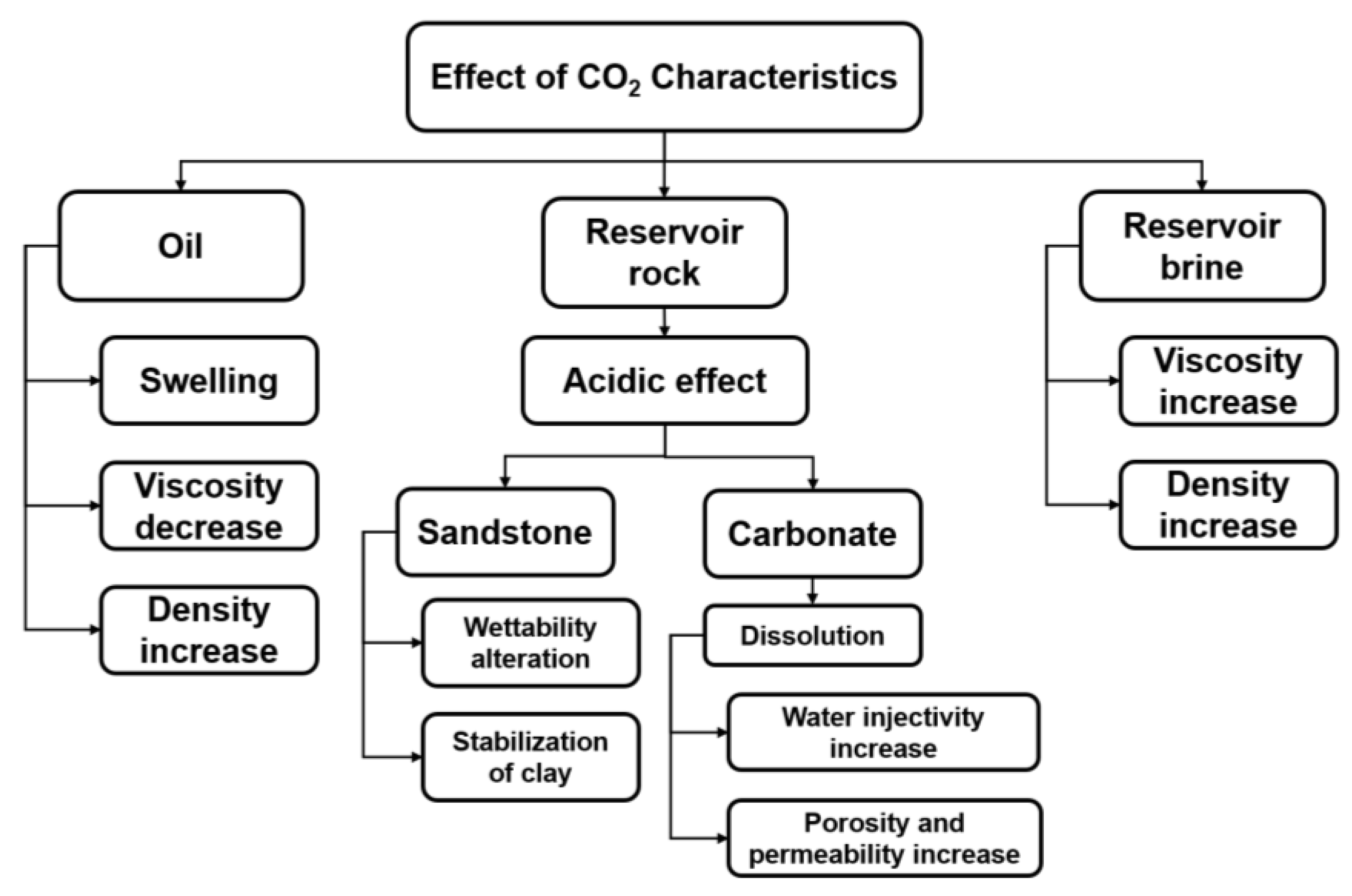

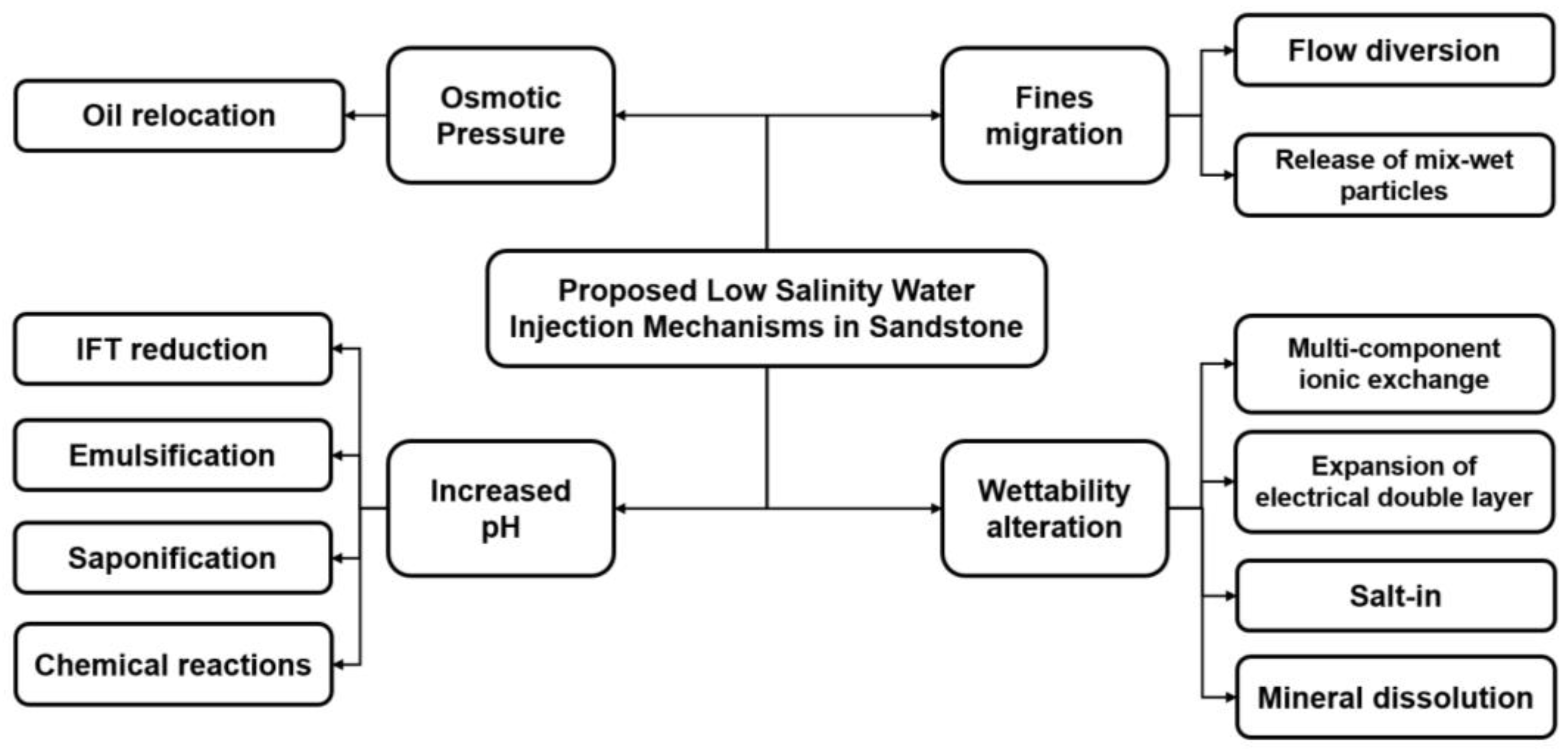
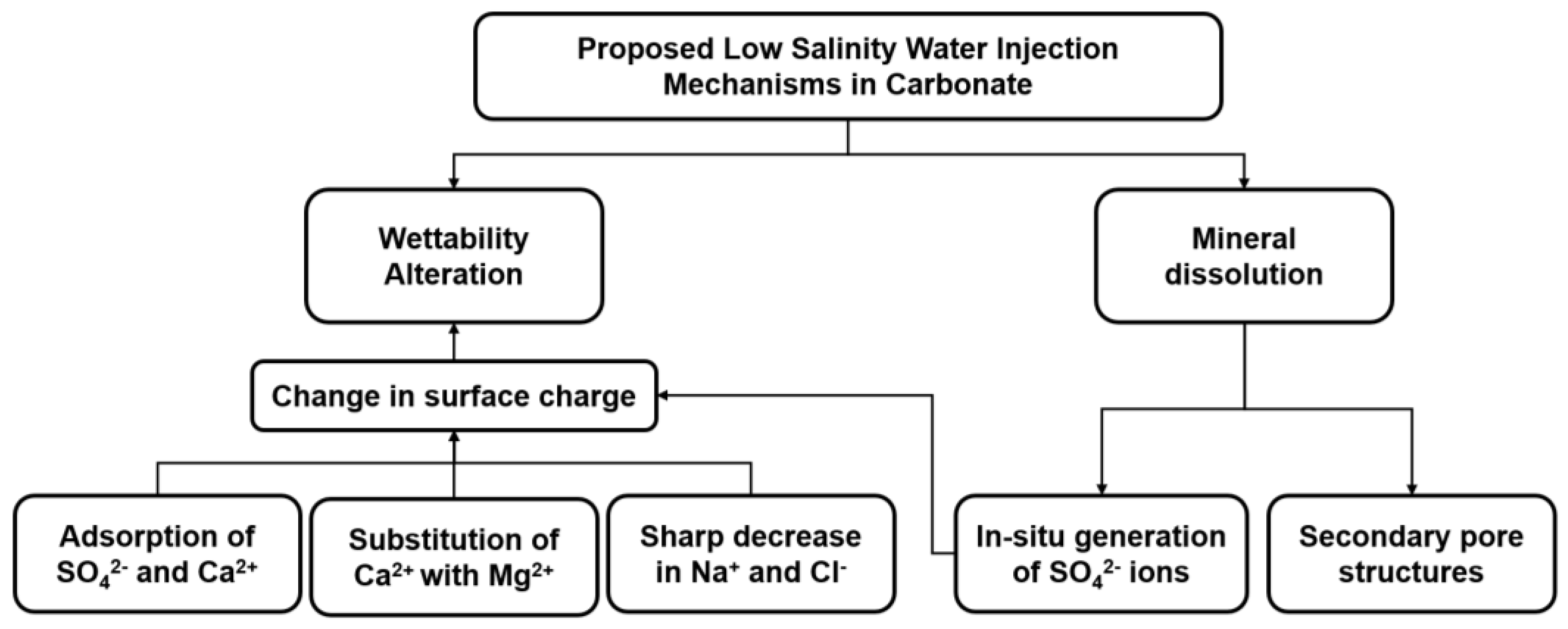

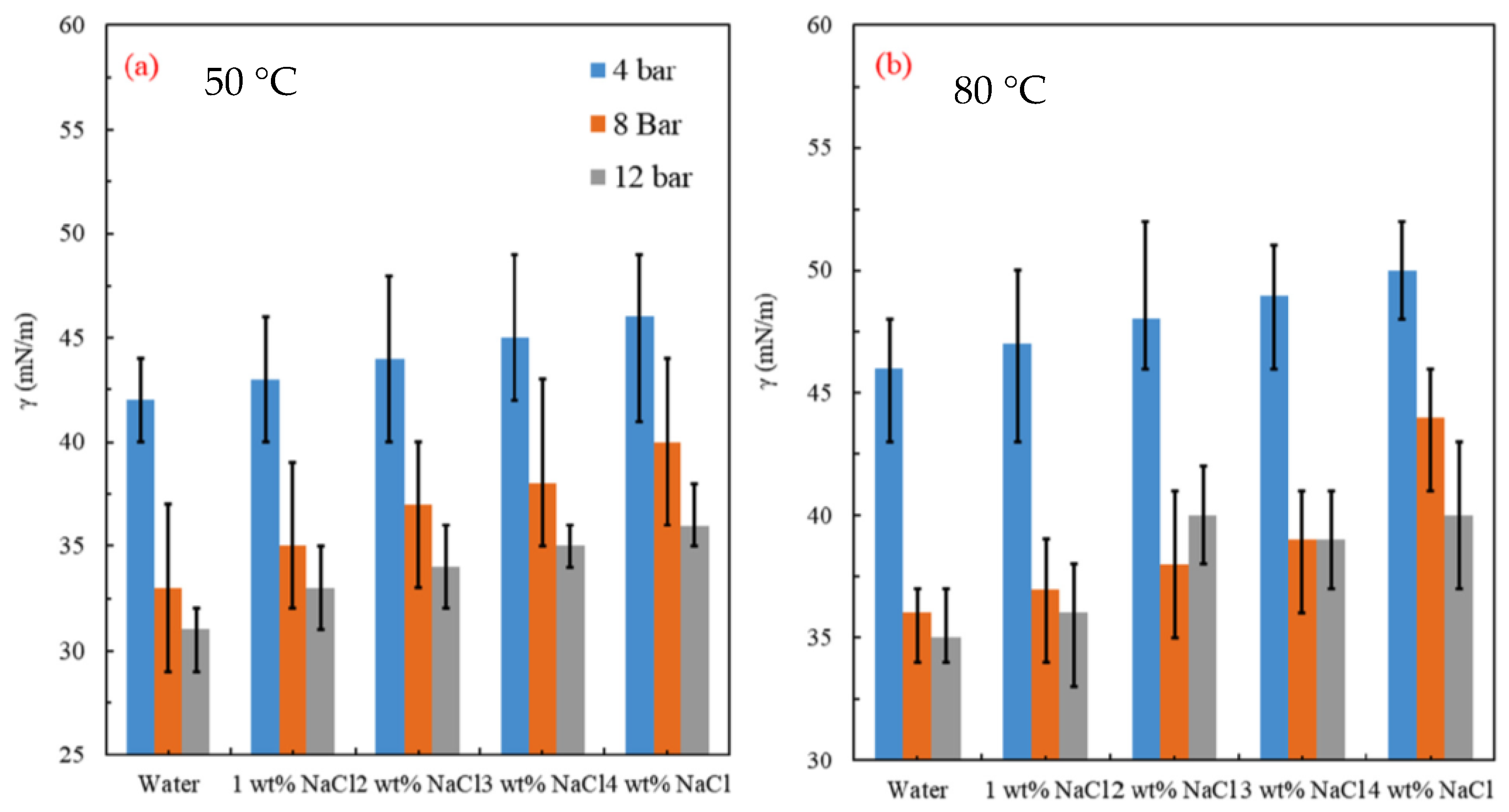
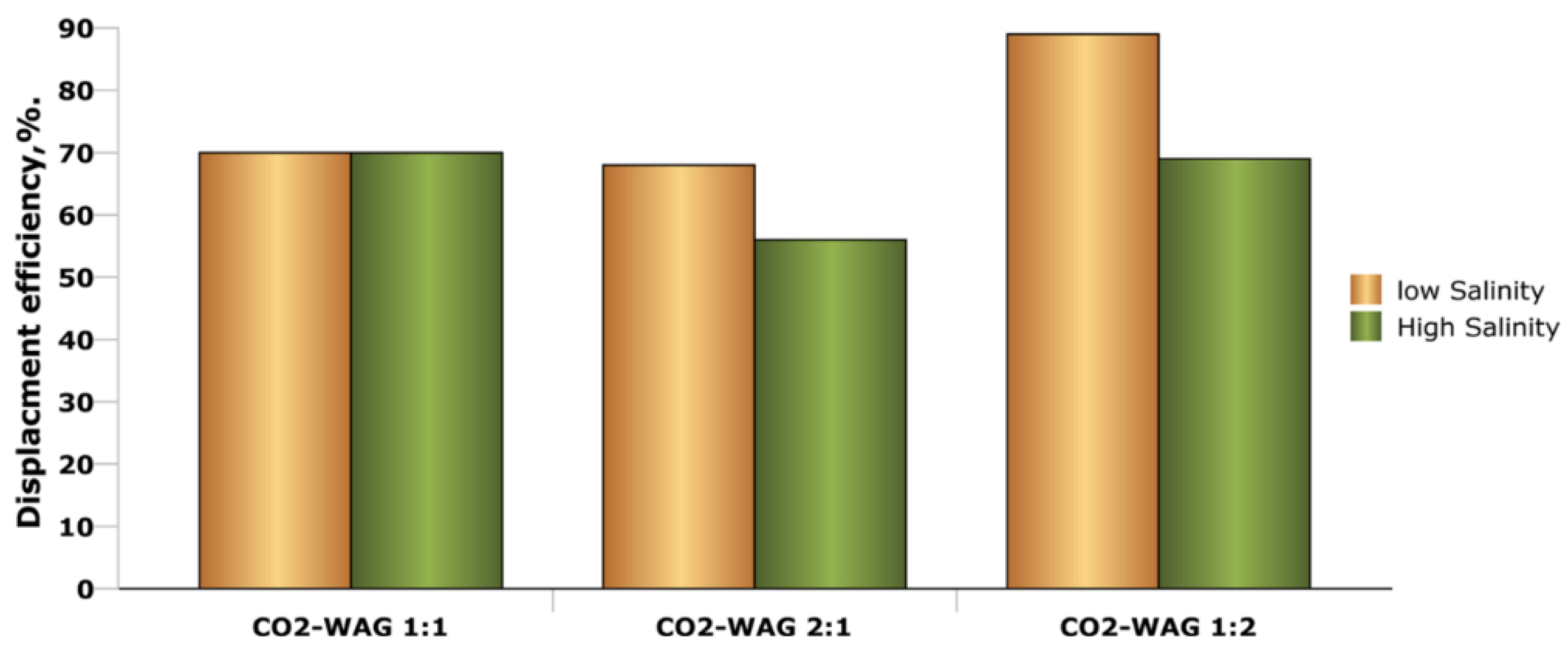



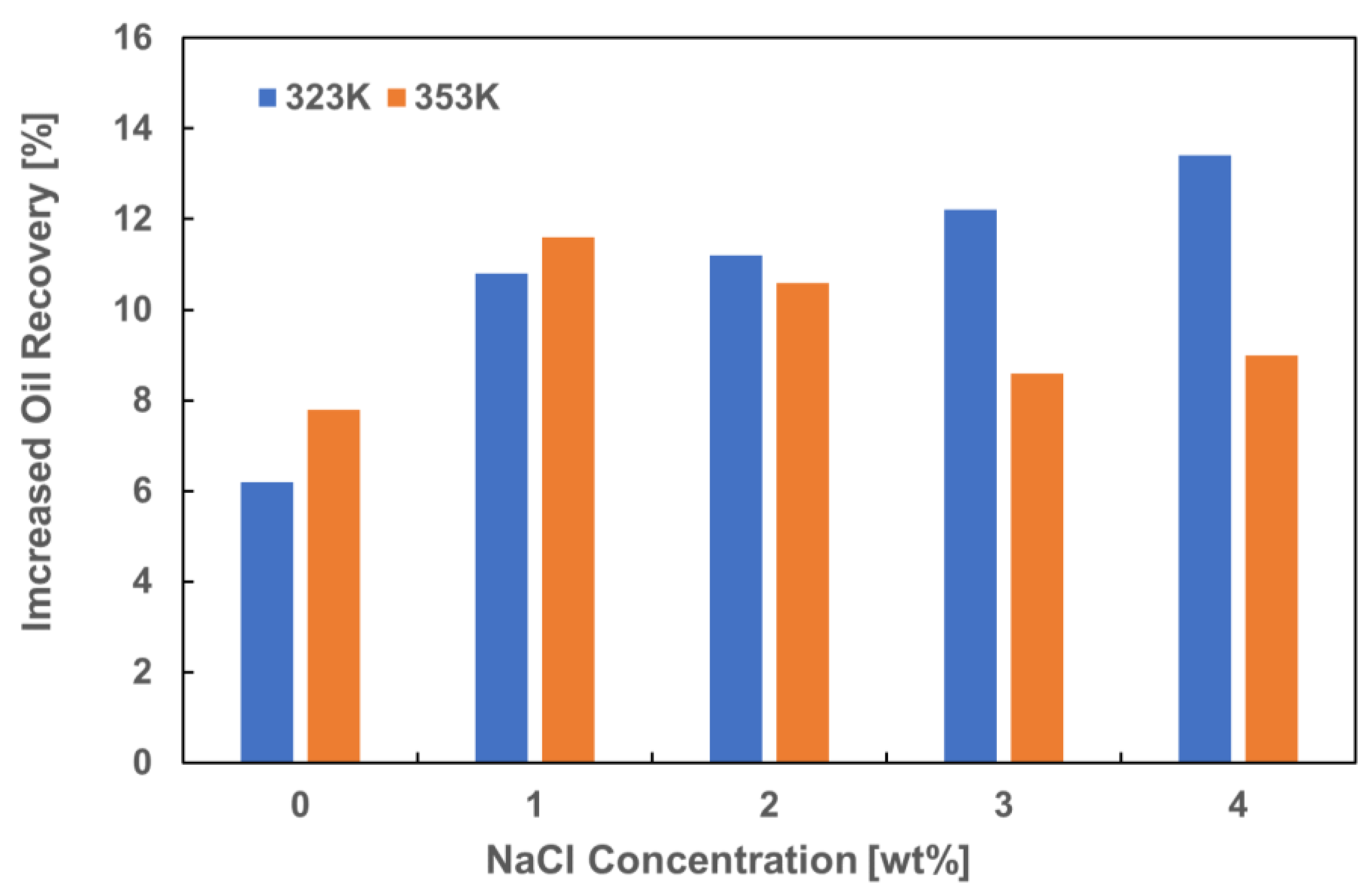
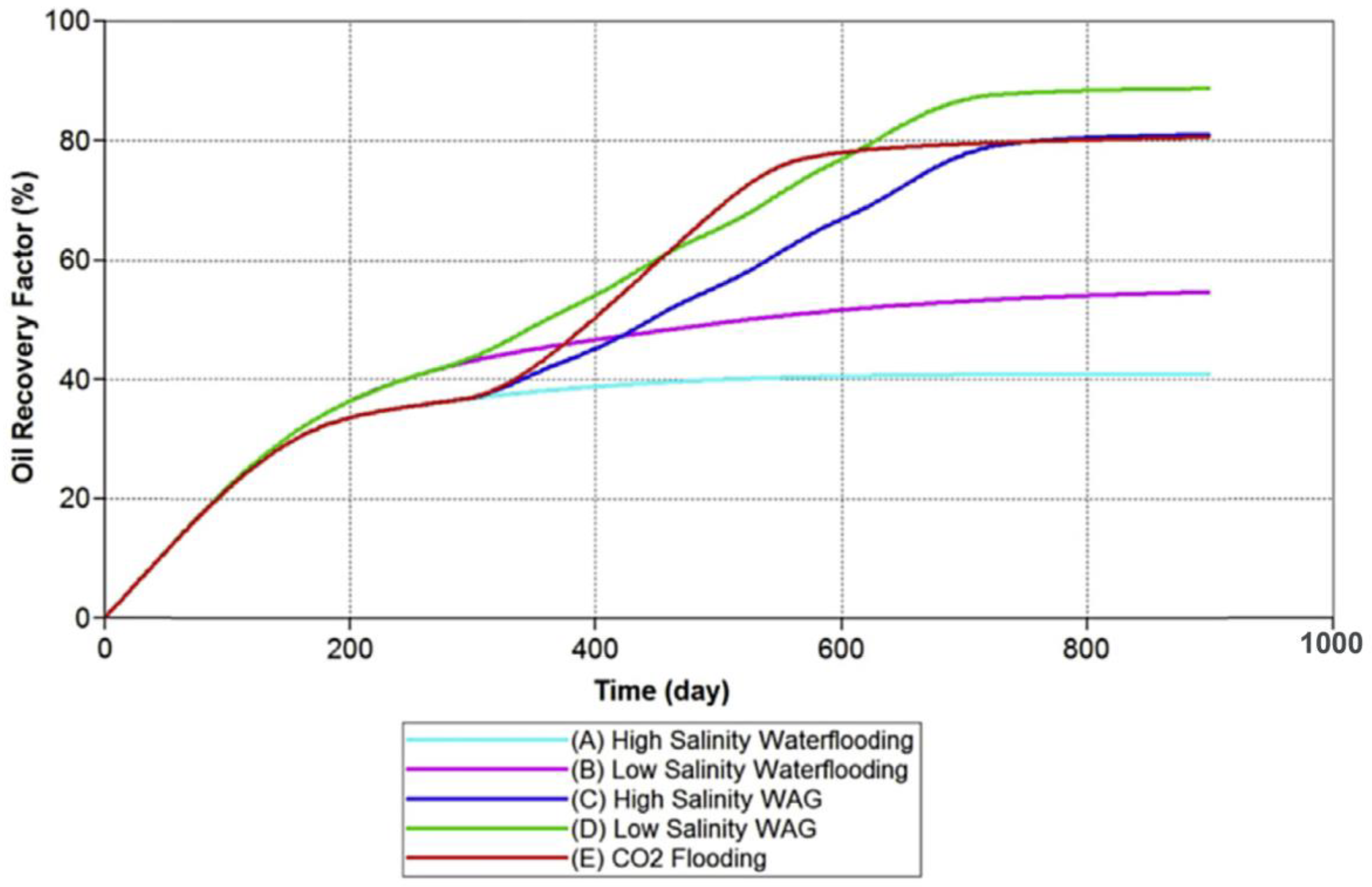

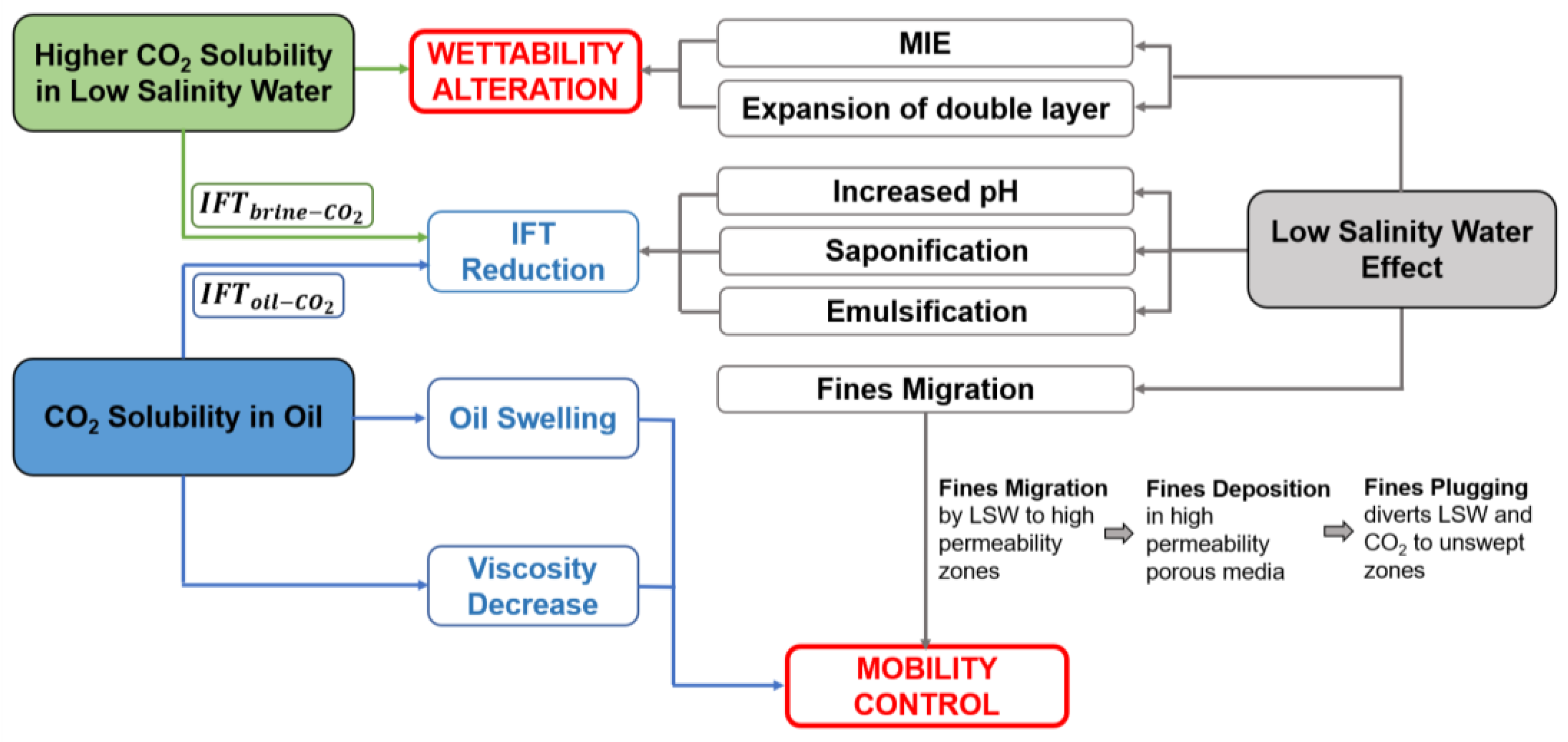

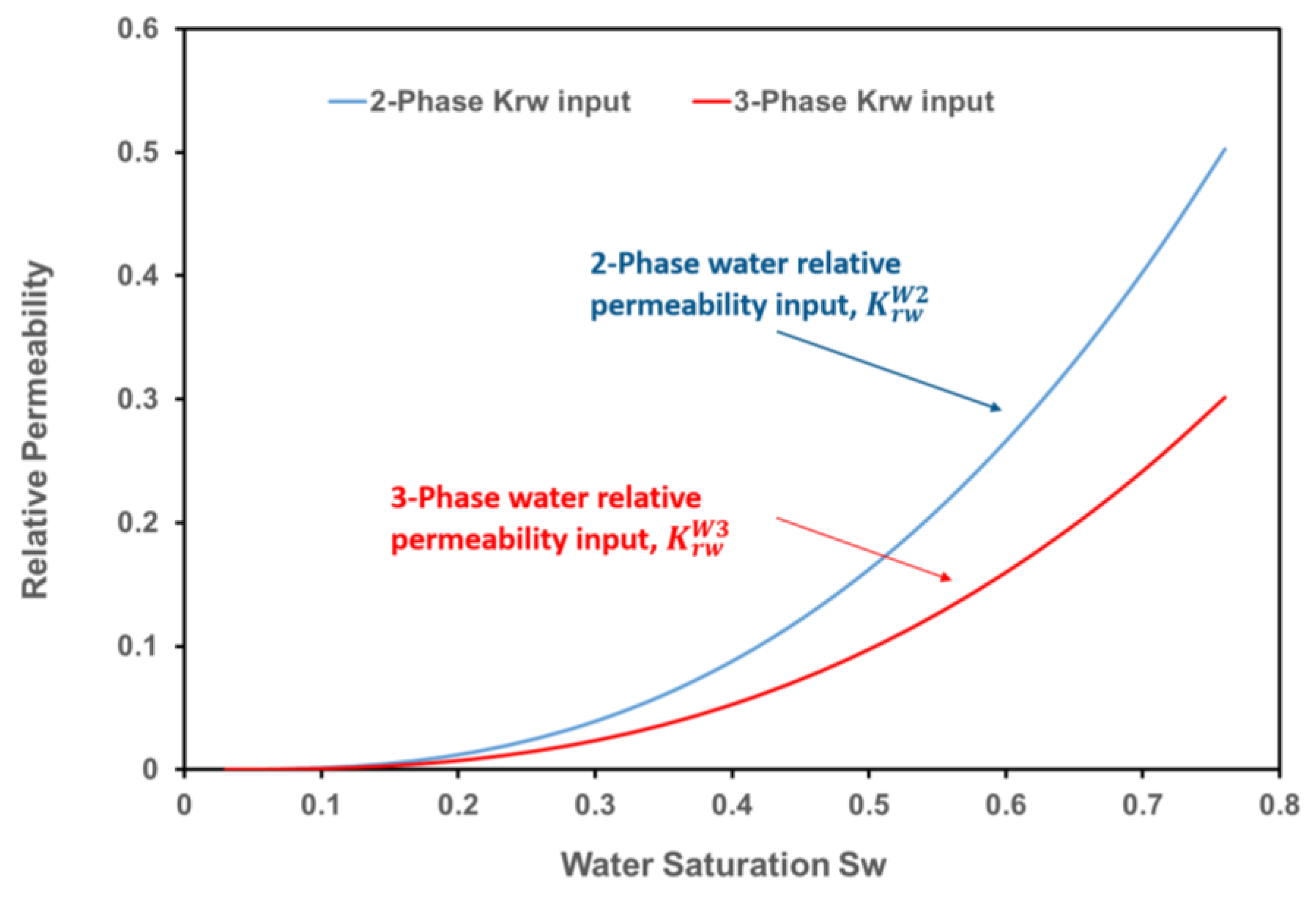
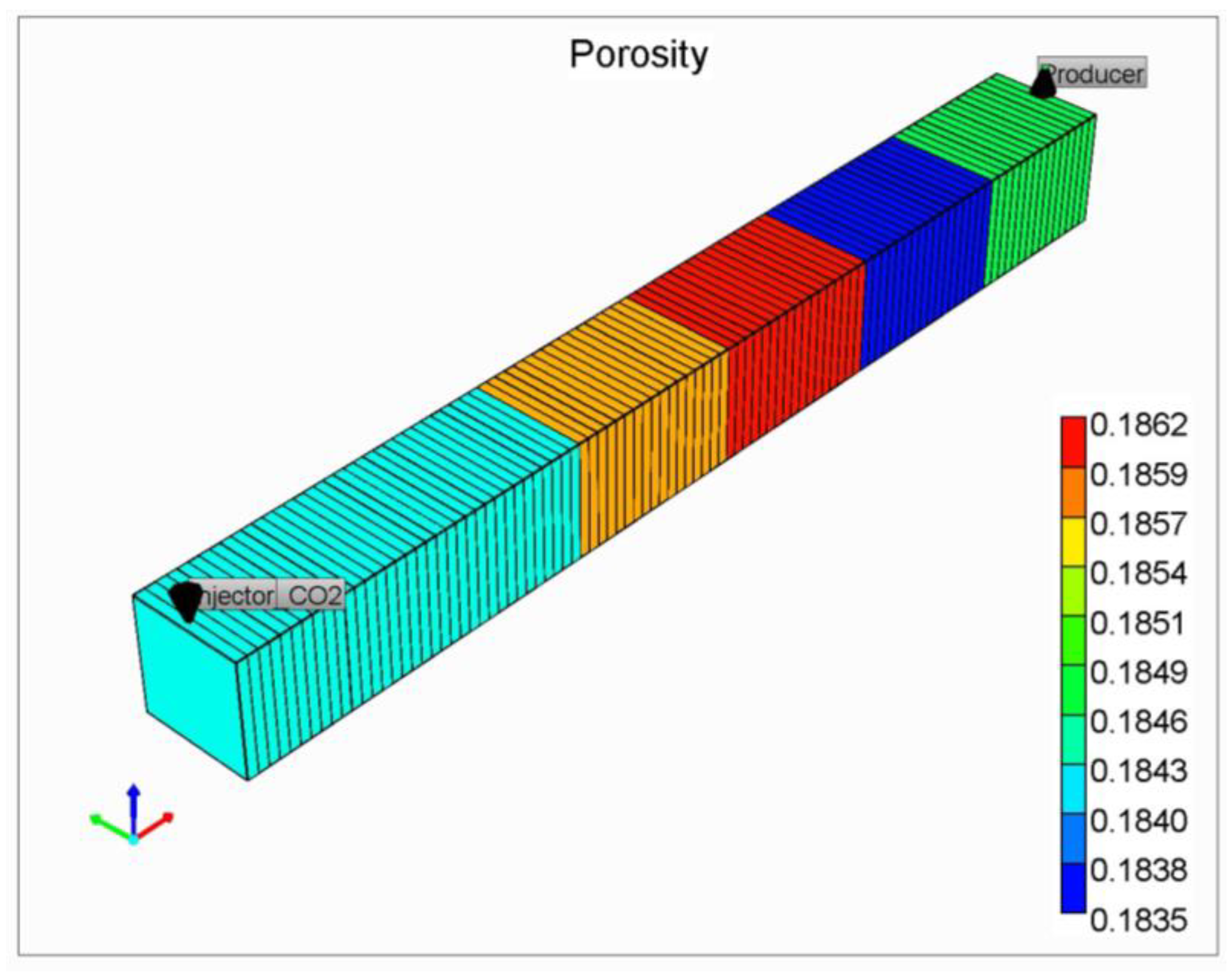

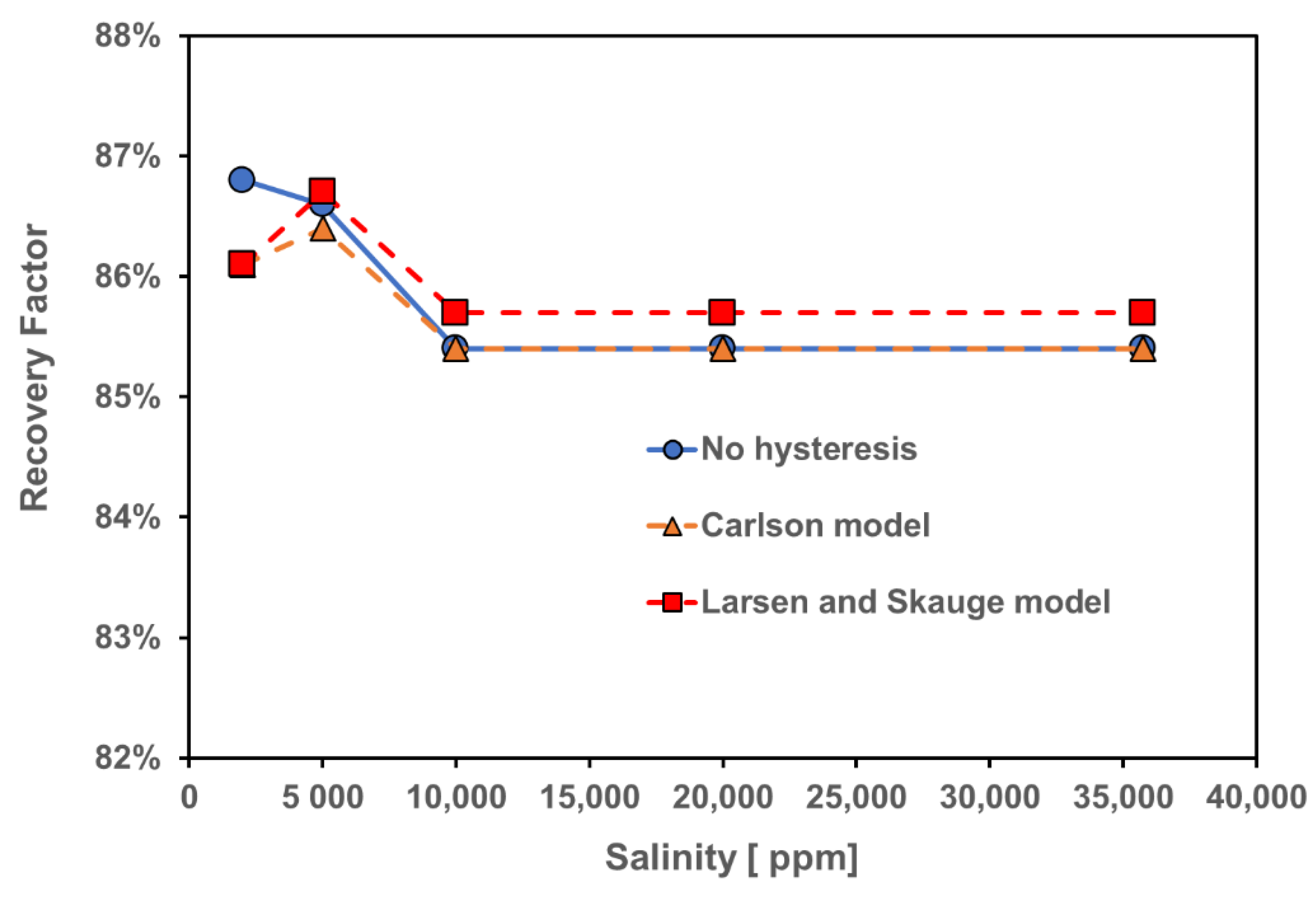
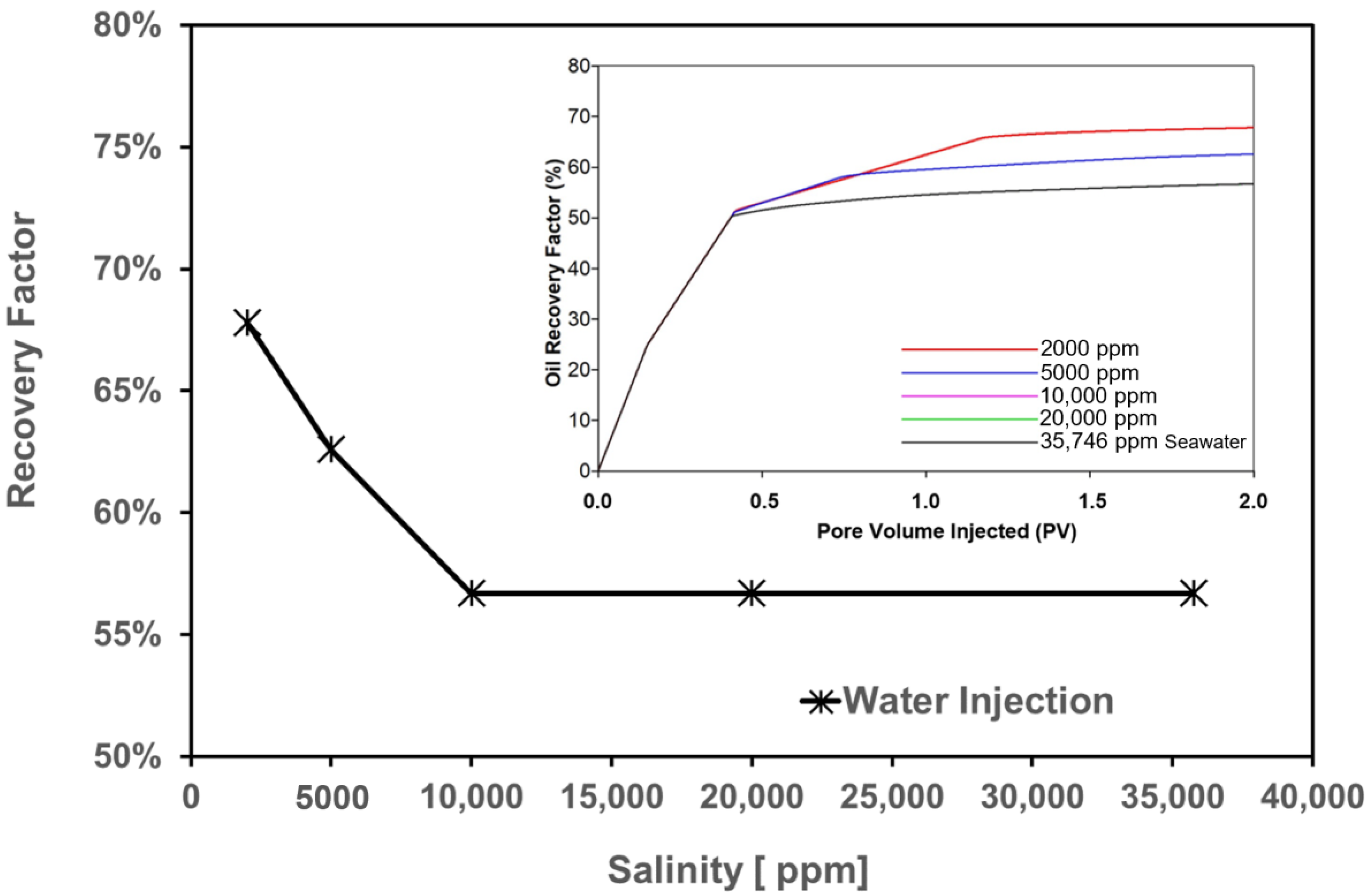
| Ref 1 | Rock Properties | Fluid Properties | Test Temp 6 [°C] | WAG Process | Total RF 13 [%] | CO2 LS WAG Injection Performance | ||||||||||
|---|---|---|---|---|---|---|---|---|---|---|---|---|---|---|---|---|
| Type | Aging | Φ 2 [%] | K 3 [mD] | Oil | FB 4 [ppm] | IB 5 [ppm] | Type | Mode | Cycle | Slug [PV] | Ratio | |||||
| [11] | Berea sandstone | 1.5 days @ 60 °C | 19.4–20.3 | 60.7–99.2 | Crude Oil 7.92 cp | 30,000 | 10,000–32,000 | 60 | MW 9 | T7 | 6 | 0.5 | 1:1 | 52–60 |
| |
| [91] | Outcrop limestone (71.6% calcite) | No aging | 29 | 90 | Crude oil | 0 6000 20,000 | 0 6000 20,000 | 49 | MW | S 8 | N/A | 0.33 | 1:1 | 74–92 |
| |
| [7] | Sandstone Kaolinite-free | 2 days @ 70 °C | 29–32 | 333–357 | Heavy oil 6.5% asphaltene 10.1 cp and 0.89 g/cm3 @ 96 °C | 50,000 | 1000 50,000 | 50 | LS 12-IMW HS 11-IMW | S | 5 | 0.16 | 1:1 | 74–92 |
| |
| [9,92] | Berea Sandstone | 14 days @ 91°C | 12 | 0.63 | Crude oil 0.87 g/cm3 | 100,000 | 25,679 12,840 1027 | 91 | IMW 10 | S, T | S: LSWI T: Immiscible CO2 flooding | 81.5 |
| |||
| [10] | Outcrop Grey Berea sandstone 6% Kaolinite and 2% Illite | No aging | 17.6–19.1 | 62–79 | Dead crude oil 0.82 g/cm3 | 174,156 | 54,680 5000 | 65 | MW | S | 3 | 2.6–8.2 | 1:1 | 61.7–64.6 |
| |
| [93] | Reservoir carbonate | No aging | N/A 14 | N/A | Crude oil 3.08 cp and 0.85 g/cm3 @ 25 °C | 163,000 | 5000 | 121 | MW | S | 2 | 0.2 | 1:2 1:2 2:1 | 58–88 |
| |
| [94] | Berea sandstone | No aging | 17–18.5 | 143–156 | Crude oil (Van Gogh) | 5000 | 5000 4000 3000 2000 1000 | 71 | MW | S | 6 3 2 | 0.2 0.4 0.6 | 1:1 | 40–55 |
| |
| [95] | Reservoir sandstone (with clay) | 1 day @ 80 °C | N/A | N/A | Crude oil 0.82 g/cm3 | 104,000 | 13,480 | 50 | IMW | S | 3 | 0.5 | 1:1 | 68 |
| |
| [96] | Bentheimer sandstone (0.5% Kaolinite) Berea sandstone (2% Kaolinite) | No aging | 22.4–22.9 | 94–207 | Light crude oil 3.58 cp and 0.83 g/cm3 | 19,751 | 36,170 3360 | 60 | HS-MW LS-MW | T | N/A | 0.2 | 1:1 | 65.2–85.2 |
| |
| [97] | Berea sandstone | No aging | 20.6–21.1 | 88.6–90.4 | Light Oil (Oman field) | 50,000 | 5000 (NaCl) 5000 (MgCl2) 5000 (KCl) | 60 | IMW | T | 3 | 0.5 | 1:1 | 45–55.4 |
| |
| [98] | Reservoir sandstone | 35 days @ 90 °C | 14–17 | 1–5 | Crude oil (Bartlesville) 600 cp and 0.83 g/cm3 @ 25 °C | 104,000 | 51,400 5140 | 50 | MW | S, T |
| 30–90 |
| |||
| [8] | Sandpack (6% Kaolinite) | No aging | 31.7–33.5 | 690–810 | Crude oil 5.1 cp and 0.85 g/cm3 @ 50 °C 2.7 cp and 0.83 g/cm3 @ 80 °C | 0 1000 2000 3000 4000 | 50 80 | S, T |
| 46–58 |
| |||||
| [99] | Carbonate Calcite (52.8%) Dolomite (16.6%) | 28 days @ 90 °C | 18 | 26–30 | Crude oil 13 cp and 0.88 g/cm3 @ 22 °C | 183,700 | 13,090 1309 | 90 | IMW | T | N/A | 0.4 | 1:1 | 68.2 |
| |
| Experiment Title | Recovery %OOIP |
|---|---|
| WAG—immiscible (NaCl brine) | 8.3% |
| WAG—miscible (NaCl brine) | 36.6% |
| WAG—immiscible (Yates reservoir brine) | 9.9% |
| WAG—miscible (Yates reservoir brine) | 25.4% |
| Parameter | FB 1 Formation Brine | HSW 2 Seawater | LSW 3 |
|---|---|---|---|
| Calcium, mg/L | 28,035.05 | 522 | 51 |
| Magnesium, mg/L | 5241.18 | 1624 | 140 |
| Sodium, mg/L | 51,809.52 | 13,416 | 1220 |
| Potassium, mg/L | - | 507 | 45 |
| Chloride, mg/L | 112,365.25 | 23,321 | 2057 |
| Total Alkalinity (as CaCO3) | - | 7993 | 707 |
| Sulfate, mg/L | - | 3479 | 378 |
| Nitrate, mg/L | - | <1 | <1 |
| Fluoride, mg/L | - | 1.8 | 0.17 |
| Total Dissolved Solids (TDS), mg/L | 197,451 | 36,170 | 3360 |
| pH | 7.37 | 6.90 | 7.05 |
| Density @ 60 °C & 14.7 psi | 1.038 | 1.021 | 0.993 |
| Viscosity @ 60 °C & 14.7 psi | 1.031 | 0.863 | 0.657 |
| Compound | FB 1 | SW 2 | SW −0NaCl 4 | MSW1 3 0NaCl-d5Ca 5 | MSW2 0NaCl-d5Mg 6 | MSW3 0NaCl-d5SO4 7 |
|---|---|---|---|---|---|---|
| NaCl | 81,000 | 25,000 | 0 | 0 | 0 | 0 |
| CaCl2 | 17,000 | 2000 | 2000 | 400 | 2000 | 2000 |
| MgCl2 | 5000 | 10,500 | 10,500 | 10,500 | 2100 | 10,500 |
| Na2SO4 | - | 4900 | 4900 | 4900 | 4900 | 980 |
| KCl | 1000 | - | - | - | - | - |
| TDS | 104,000 | 43,400 | 18,400 | 15,800 | 9000 | 13,480 |
| Flooding Sequence | Recovery %OOIP |
|---|---|
| 2 PV SW | 43.64 |
| 2 PV SW, 5 PV CO2 | 47.64 |
| 2 PV SW, 3 PV SW-0NaCl, and 5 PVCO2 | 52.70 |
| 2 PV SW, 3 PV MSW1, and 5 PV CO2 | 63.45 |
| 2 PV SW, 3 PV MSW2, and 5 PV CO2 | 58.65 |
| 2 PV SW, 3 PV MSW3, and 5 PV CO2 | 55.83 |
| 2 PV SW, 3 PV MSW1/CO2 (3 cycles, 0.5 PV slug size) | 68.14 |
| Rock Type | Description of Experiment | Total Recovery %OOIP |
|---|---|---|
| Berea Sandstone | CO2 HS WAG Injection | 65.20 |
| CO2 LS WAG Injection | 82.40 | |
| Bentheimer Sandstone | CO2 HS WAG Injection | 85.18 |
| CO2 LS WAG Injection | 72.65 |
| Condition A | Core disc was aged for three weeks at reservoir temperature Seawater is between the disc and oil-droplet during contact angle measurement |
| Condition B | Aged disc was kept in a piston with seawater and CO2 for 2 days Seawater and CO2 is between the disc and oil-droplet during contact angle measurement |
| Condition C | Aged disc was kept in a piston with low salinity water and CO2 Low salinity water and CO2 is between the disc and oil-droplet during contact angle measurement |
| Sample No. | Brine | WI | |||
|---|---|---|---|---|---|
| 1 | HS 1 (50,000 ppm) | 51.24 | 118.19 | 71.43 | 0.70 |
| 2 | HS (50,000 ppm)—CO2 | 51.24 | 114.33 | 42.12 | 1.14 |
| 3 | NaCl (5000 ppm) | 51.24 | 133.85 | 36.44 | 1.18 |
| 4 | NaCl (5000 ppm)—CO2 | 51.24 | 118.78 | 33.34 | 1.27 |
| 5 | KCl (5000 ppm) | 51.24 | 109.45 | 41.95 | 1.16 |
| 6 | KCl (5000 ppm)—CO2 | 51.24 | 122.33 | 43.58 | 1.11 |
| 7 | MgCl2 (5000 ppm) | 51.24 | 126.21 | 52.37 | 0.98 |
| 8 | MgCl2 (5000 ppm)—CO2 | 51.24 | 101.23 | 35.26 | 1.32 |
| Potential for Enhanced Oil Recovery | Initial Wettability | ||
|---|---|---|---|
| Water-Wet | Intermediate-Wet to Oil-Wet | ||
| Clay Content | No Clay | 1 reviewed article indicates EOR potential [7] | / |
| <0.5% Clay | 2 reviewed articles indicate EOR potential [95,97] 2 reviewed articles indicate no EOR potential [11,96] | 2 reviewed articles indicate EOR potential [9,98] | |
| 2–6% Clay | 2 reviewed articles indicate EOR potential [8,96] 1 reviewed article indicates no EOR potential [10] | / | |
| Parameter | Value |
|---|---|
| Grid block system | 100 × 1 × 1 |
| Grid block sizes | ∆x = 0.312 cm, ∆y = 3.345 cm, ∆z = 3.345 cm |
| Porosity | 17 × 0.1845, 17 × 0.1845, 17 × 0.1859, 17 × 0.1862, 17 × 0.1835, 15 × 0.1846 |
| Permeability (mD) | 17 × 2412, 17 × 2235, 17 × 2280, 17 × 2285, 17 × 2180, 15 × 2240 |
| Initial water saturation | 0.03 |
| Reservoir temperature | 100 °C |
| Initial reservoir pressure | 42,446 kPa (6156 psi) |
| Injection rate | 11 cm3/h |
| WAG ratio | 1:1 |
| Total pore volume injected | 2 |
| Equation of state | Soave-Redlich-Kwong |
| Bubble point | 37,335 kPa (5414 psi) |
| Oil API gravity | 32 |
| Formation volume factor | 1.68 rm3/sm3 |
| Component | Formation Water | Seawater | Low Salinity Water |
|---|---|---|---|
| Na+, mg/L | 35,671 | 10,974 | 614 |
| Mg2+, mg/L | 330 | 1310 | 73 |
| Ca2+, mg/L | 3599 | 420 | 23 |
| K+, mg/L | 225 | 407 | 23 |
| Cl−, mg/L | 62,371 | 19,740 | 1104 |
| SO42−, mg/L | 233 | 2766 | 155 |
| HCO3−, mg/L | - | 129 | 7 |
| Total | 102,430 | 35,746 | 2000 |
| Case | Recovery Scheme | Hysteresis Model | Land Parameter | Gas Reduction Factor | Recovery Factor | % Difference from Base Case |
|---|---|---|---|---|---|---|
| #1 | CO2 WAG | None | N/A | N/A | 85.4% | Base 1 |
| #2 | 2 Phase | 0.8 | N/A | 85.4% | 0% | |
| #3 | 3 Phase | 0.8 | 3.32 | 85.7% | 0.35% | |
| #4 | CO2 LS WAG | None | N/A | N/A | 86.6% | Base 2 |
| #5 | 2 Phase | 0.8 | N/A | 86.1% | −0.8% | |
| #6 | 3 Phase | 0.8 | 3.32 | 86.1% | −0.8% |
Publisher’s Note: MDPI stays neutral with regard to jurisdictional claims in published maps and institutional affiliations. |
© 2022 by the authors. Licensee MDPI, Basel, Switzerland. This article is an open access article distributed under the terms and conditions of the Creative Commons Attribution (CC BY) license (https://creativecommons.org/licenses/by/4.0/).
Share and Cite
Ma, S.; James, L.A. Literature Review of Hybrid CO2 Low Salinity Water-Alternating-Gas Injection and Investigation on Hysteresis Effect. Energies 2022, 15, 7891. https://doi.org/10.3390/en15217891
Ma S, James LA. Literature Review of Hybrid CO2 Low Salinity Water-Alternating-Gas Injection and Investigation on Hysteresis Effect. Energies. 2022; 15(21):7891. https://doi.org/10.3390/en15217891
Chicago/Turabian StyleMa, Shijia, and Lesley A. James. 2022. "Literature Review of Hybrid CO2 Low Salinity Water-Alternating-Gas Injection and Investigation on Hysteresis Effect" Energies 15, no. 21: 7891. https://doi.org/10.3390/en15217891
APA StyleMa, S., & James, L. A. (2022). Literature Review of Hybrid CO2 Low Salinity Water-Alternating-Gas Injection and Investigation on Hysteresis Effect. Energies, 15(21), 7891. https://doi.org/10.3390/en15217891






